The Samaritans
Caretakers of Jeroboam’s anti-Jerusalem Ideology
"The pagan half-Jews."
"Neo-Jeroboamites"
2 Kings 17:7-41
723 BC-70 AD
See also: The Samaritan Pentateuch
Introduction:
1. The anti-Jerusalem philosophies of the Samaritans originated with Jeroboam.
a. This is why we call the Samaritans, "Neo-Jeroboamites". Samaritans carry on the basic traditions that Jeroboam set in order in 931 BC when he set up two pagan worship centers to replace Jerusalem: Bethel and Dan.
b. The Samaritan temple on Mt. Gerizim venerated the Altar of Joshua which was built on Mt. Gerizim. The Samaritans had chose Mt. Gerizim as their holy place because that is the original location of Joshua’s Altar.
c. See full outline on Joshua’s altar on Mt. Gerizim NOT Mt. Ebal
d. A small population that had been deported in 723 BC from the tribes of Manasseh and Ephraim, were brought back by Shalmaneser and they intermarried with the Gentiles.
e. To the Samaritans, Mt. Gerizim is their "Jerusalem".
f. This has caused the Jews to hold the Samaritans with contempt to this day. The Samaritans and the Jews are historic enemies.
2. The Samaritans were a pagan sect that grew out of the tribes of Manasseh and Ephraim after their deportation in 723 BC into Assyria by Shalmaneser.
a. Assyrian king Shalmaneser V, 727-722 BC deported Israel into captivity in 723 BC, but died the following year.
b. Sargon II (Assyria) 722-705 BC sends a group of Assyrians to inhabit Samaria/Israel but YHWH kills them with lions which they interpret as an omen.
c. The Assyrians living in Israel ask Sargon II for a priest of Bethel who had been recently deported.
d. We don't know this priest's name but he must have been prominent, given he was chosen by Sargon II to represent the God of Israel.
e. What Sargon II did not know was that this was an evil priest… the very likes of whom God had destroyed the ten tribes to begin with due to the very idolatry he was now promoting again at Bethel after the 723 deportation.
f. At Bethel, following in the footsteps of Jeroboam (931 BC), idol worship stood beside the true worship of YHWH down to the Babylonian captivity of 587 BC.
g. After the return of Judah, the Samaritans ceased to worship idols, but they invented a brand new alternate religion where they chose Mt. Gerizim as their holy mountain in direct opposition to Jerusalem. This action was a continuation of Jeroboam's policy of separating the ten northern tribes from the one true God at Jerusalem. His famous quote: "It is too far for you to go up to Jerusalem… worship at Bethel or Dan" says it all.
h. The "Samaritans" intermarried with the pagans, a point of contention between them and the pure blooded Jews, that continued down to the woman at the well of John 4.
i. The Samaritans, therefore represented all the worst of the Jews in that they opposed God's choice of David, Jerusalem and polluted their bloodlines which forever disqualified them from producing the Messiah, Jesus Christ.
j. The woman at the well was told by Jesus that they were totally wrong and in error: "Jesus said to her, “Woman, believe Me, an hour is coming when neither in this mountain nor in Jerusalem will you worship the Father. “You worship what you do not know; we worship what we know, for salvation is from the Jews." (John 4:21-22)
3. In the New Testament, Jesus used the "parable of the good Samaritan" as an example of how lost Samaritans can be more moral, than those who consider themselves saved.
4. The Samaritans had three periods of development:
a. Incubation stage in the anti-Jerusalem ideology promoted by Jeroboam which laid the ground work for the sect to develop. (931 - 723 BC)
b. The birth stage of becoming a formal "Samaritan sect" in reaction to Nehemiah's efforts to rebuilt Jerusalem as the center of Mosaic religion. (723 -538 BC)
c. The born again stage in their conversion to Christ by being baptized for the remission of their sins upon their confession of faith. (33 AD)
5. In 622 AD the devil would duplicate another counterfeit religion through Mohammed who said that Mecca was the place where Abraham sacrificed Ishmael. For the Muslims, Mecca is their Jerusalem.
6. See also: The
Samaritan Pentateuch

I. Historical summary of the Samaritans:
1. 2100 BC: Tel el Balata: Ancient Shechem at the time of Abraham:
a. Pictured is the author sitting in the pagan Canaanite altar in the sanctuary on the summit of Tel Balata.
b.
It is not actually a “man chair” but an altar for sacrifice.

2. In 2091 BC Abraham left Haran at age 75 and the same year God appeared to him at Shechem: Gen 12:4.
a. In 2091 BC, Abraham built an altar in Shechem beside the Oak of Moreh where God appeared to him and promised to give his seed the land: "Abram passed through the land as far as the site of Shechem, to the oak of Moreh.
b. Now the Canaanite was then in the land.
c. The Lord appeared to Abram and said, "To your descendants I will give this land." So he built an altar there to the Lord who had appeared to him." Genesis 12:6-7.
d. Regarding the "Oaks of Moreh": Not just a single oak tree but a forest called the "oaks of Moreh" were located near, but not in Shechem, (Genesis 35:4) and apparently not directly on either of the two mountains: "Are they [Mount Gerizim & Ebal] not across the Jordan, west of the way toward the sunset, in the land of the Canaanites who live in the Arabah, opposite Gilgal, beside the oaks of Moreh?" Deuteronomy 11:29-30.
e.
The location of the oaks of Moreh are clearly outside
the formal city limits of Shechem: "Then Hamor the father of Shechem went out to Jacob to speak with him." Genesis
34:6
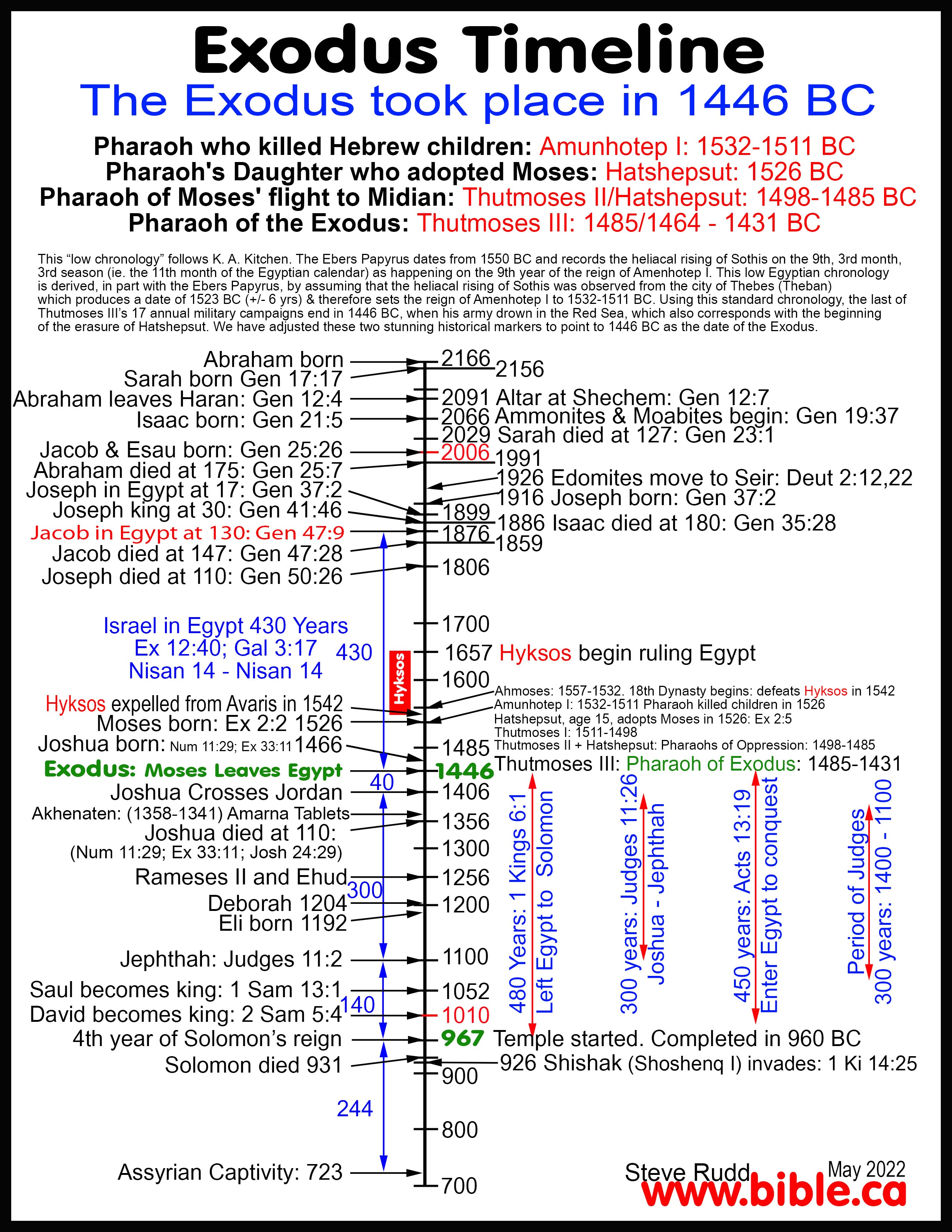
3. In 1930 BC, Jacob after he had fled from Laban back to Canaan, he built an altar at the place he camped "before the city of Shechem", not in Shechem.
a. He bought this land: "Now Jacob came safely to the city of Shechem, which is in the land of Canaan, when he came from Paddan-aram, and camped before the city. He bought the piece of land where he had pitched his tent from the hand of the sons of Hamor, Shechem's father, for one hundred pieces of money.
b. Then he erected there an altar and called it El-Elohe-Israel." Genesis 33:18-20
c. In 1910 BC, just before Jacob moved from Shechem to Bethel, he hid the idols of his family under the "oak of Moreh" which was the very spot where Abraham had built an altar: "So they gave to Jacob all the foreign gods which they had and the rings which were in their ears, and Jacob hid them under the oak which was near Shechem." Genesis 35:4
d. In 1899 BC, Joseph was sold into slavery. Jacob sent Joseph to Shechem to find his brothers, who had moved on to Dothan, where they betrayed him: "Israel said to Joseph, "Are not your brothers pasturing the flock in Shechem? Come, and I will send you to them." And he said to him, "I will go."" Genesis 37:13
4. 1406 BC: Joseph buried, Joshua’s altar on Mt. Gerizim
a. See full outline on Joshua’s altar on Mt. Gerizim NOT Mt. Ebal
b. When Israel crossed the Jordan, the tabernacle was first set in the Gilgal (Josh 4:19).
c. In 1406 BC, Joshua traveled from Gilgal, where the tabernacle was located, to Mt. Ebal (or Mt. Gerizim) beside Shechem to built the "altar of Joshua".
d. 1406 BC Joseph was buried in Shechem in a plot of land Jacob had bought: "Now they buried the bones of Joseph, which the sons of Israel brought up from Egypt, at Shechem, in the piece of ground which Jacob had bought from the sons of Hamor the father of Shechem for one hundred pieces of money; and they became the inheritance of Joseph's sons." Joshua 24:32; Genesis 33:18-20; Acts 7:16.
e.
The ark of the covenant was taken to Shechem and used
in the blessings and curses ceremony, while the tabernacle remained at Gilgal.
Josh 8:30
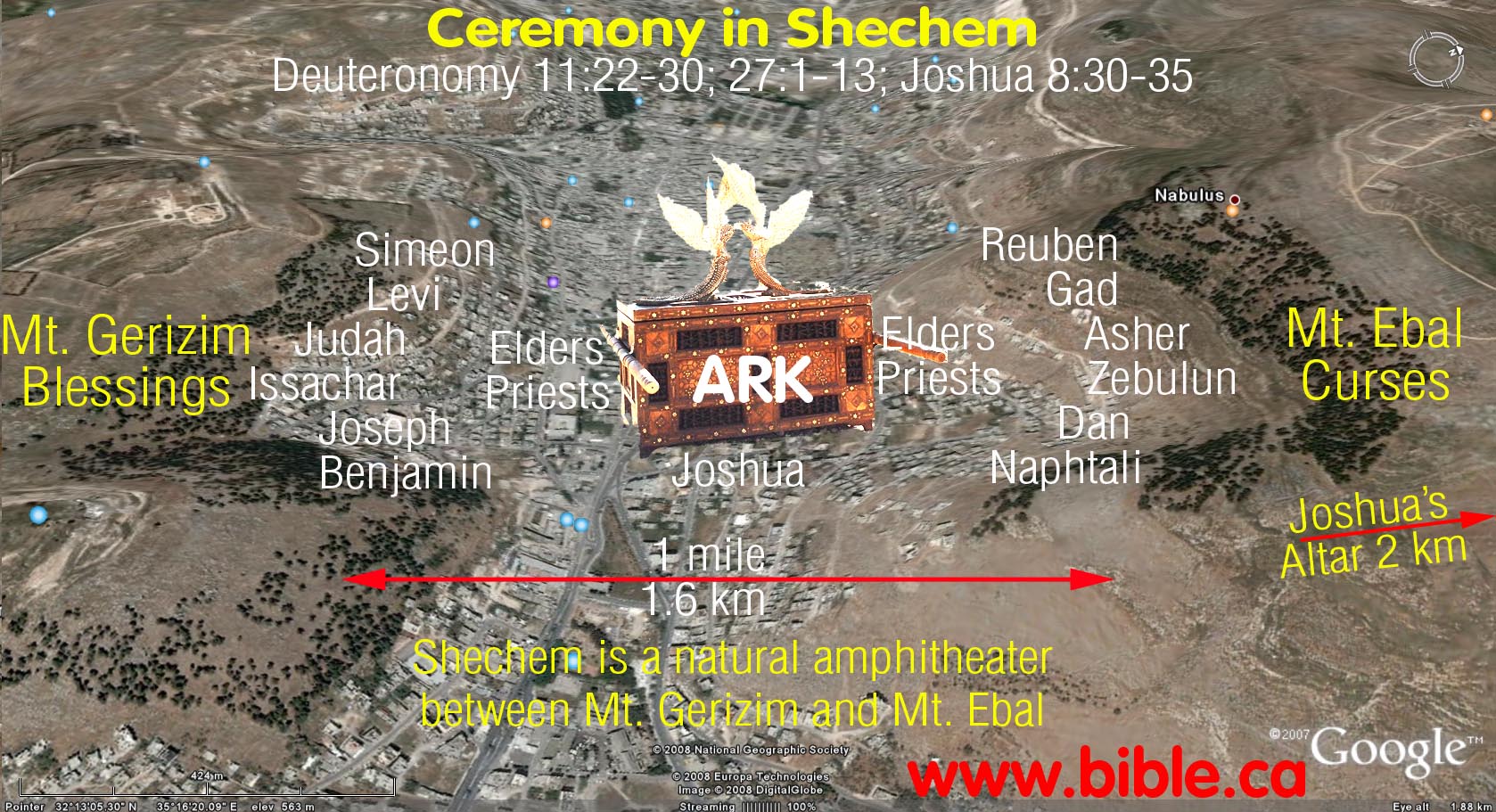
5.
1399: Tabernacle tent moved to Shiloh: Josh 18:1,10

a. In 1399 BC Joshua set up the tabernacle "sanctuary of the Lord" from Gilgal to Shechem and placed near the Oaks of Moreh. Joshua gathered all the people there for his farewell address: "Then Joshua gathered all the tribes of Israel to Shechem, ... and they presented themselves before God." (Joshua 24:1).
b. He also set up a memorial stone directly underneath the very oak that Abraham had built an altar near and Jacob had hid his family idols underneath.
c. "So Joshua made a covenant with the people that day, and made for them a statute and an ordinance in Shechem. And Joshua wrote these words in the book of the law of God; and he took a large stone and set it up there under the oak [of Moreh] that was by the sanctuary of the Lord. Joshua said to all the people, "Behold, this stone shall be for a witness against us, for it has heard all the words of the Lord which He spoke to us; thus it shall be for a witness against you, so that you do not deny your God." Then Joshua dismissed the people, each to his inheritance." Joshua 24:25-28
d. Joshua divided up the land by lot (Joshua 19:51). Shiloh was the central gathering point for Israel at the time of Joshua: "When the sons of Israel heard of it, the whole congregation of the sons of Israel gathered themselves at Shiloh to go up against them in war." Joshua 22:12.
e. In 110 AD, Josephus says that the tabernacle was first at Gilgal, then Shiloh after which Joshua built the Altar on Mt. Ebal. The correct order was Gilgal, Ebal, Shiloh: "The fifth year was not past, and there was not one of the Canaanites remained any longer, excepting some that had retired to places of great strength. So Joshua removed his camp to the mountainous country, and placed the tabernacle in the city of Shiloh, for that seemed a fit place for it, because of the beauty of its situation, until such time as their affairs would permit them to build a temple; and from thence he went to Shechem, together with all the people, and raised an altar where Moses had beforehand directed; then did he divide the army, and place one half of them on Mount Gerizim, and the other half on Mount Ebal, on which mountain the altar was; he also placed there the tribe of Levi, and the priests. (And when they had sacrificed, and denounced the [blessings and the] curses, and had left them engraved upon the altar, they returned to Shiloh. (Josephus, Antiquities 5.1.19, 68-70)
f. In 1399 BC, Shechem became a central "city of refuge" for Ephraim and Manasseh: "They gave them Shechem, the city of refuge for the manslayer, with its pasture lands, in the hill country of Ephraim, and Gezer with its pasture lands," Joshua 21:21 (Josh 20:2,7; 1 Chronicles 6:67)
g. In 1399, From Shiloh, Joshua sent the tribe of Reuben transjordan for their inheritance: Joshua 22:9. The sons of Reuben built an exact replica of the altar of burnt offering in the tabernacle at Shiloh on the east side of the Jordan which created a huge problem. Altars had to be endorsed directly by God or else they were considered apostate and rebellious: "Thus says the whole congregation of the Lord, 'What is this unfaithful act which you have committed against the God of Israel, turning away from following the Lord this day, by building yourselves an altar, to rebel against the Lord this day?" Joshua 22:16 "Therefore we said, 'It shall also come about if they say this to us or to our generations in time to come, then we shall say, "See the copy of the altar of the Lord which our fathers made, not for burnt offering or for sacrifice; rather it is a witness between us and you." '" Joshua 22:28
6. 1356 BC Joshua dies on the first Jubilee year of Israel:
a. Joshua lived 1466 - 1356 BC: Joshua is described as a young man, a youth, when Israel left Egypt: (Ex 33:11; Num 11:28) He was chosen by Moses to fight Amalek at (Exodus 17:9) Rephidim.
b. Since the exodus was 1446 BC and Joshua lived to be 110 years old. (Joshua 24:29)
c. This means Joshua was born about 1466 BC and died 1356 BC.
d. Joshua began serving Moses at age 20, and served Moses for 40 years in the wilderness and then 50 years in Canaan after crossing the Jordan.
e. Jubilees are 49 year intervals beginning when Israel crossed the Jordan in 1406 BC. 1406-49= 1357 or 1356 BC inclusive counting.
7.
1340 BC: Danite Pagan altar and
high place at Tel Dan: 1340-931 BC

a. "Dan shall judge (test) his people (through their idolatry), as one of the tribes of Israel. Dan shall be a serpent in the way, a horned snake in the path, That bites the horse's heels, So that his rider falls backward (in 722 BC). For Your salvation I wait, O Lord." (Genesis 49:16-18
b. "The sons of Dan set up for themselves the graven image; and Jonathan, the son of Gershom, the son of Moses, he and his sons were priests to the tribe of the Danites until the day of the captivity of the land (723 BC)." (Judges 18:30)
8. 931 BC: First anti-Jerusalem religion with capital at Shechem (Mt. Gerizim) by Jeroboam
a. Jeroboam inherits and expands the Danite altar and builds a duplicate at Bethel. The Danite pagan altar at Tel Dan becomes a template for his new religion founded at Shechem.
b. "Then Jeroboam built Shechem in the hill country of Ephraim, and lived there. And he went out from there and built Penuel. Jeroboam said in his heart, “Now the kingdom will return to the house of David. “If this people go up to offer sacrifices in the house of the Lord at Jerusalem, then the heart of this people will return to their lord, even to Rehoboam king of Judah; and they will kill me and return to Rehoboam king of Judah.” So the king consulted, and made two golden calves, and he said to them, “It is too much for you to go up to Jerusalem; behold your gods, O Israel, that brought you up from the land of Egypt.” He set one in Bethel, and the other he put in Dan. Now this thing became a sin, for the people went to worship before the one as far as Dan." (1 Kings 12:25–30)
c. Contrary to popular opinion, Jeroboam was merely a side-show and a "Johnny-come-lately", in the idolatry at tel Dan. It all started hundreds of years before he was born in 1340 BC when Micah's idolatry was transplanted to Dan (Judges 17-19) and the Jonathan, the grandson of Moses founded a dynastic pagan priesthood which endured until the tribe of Dan went extinct in 723 BC. (Judges 18:30)
d. So evil was the tribe of Dan in leading all Israel into idol worship, that they are not listed as one of the 12 tribes in heaven in the book of Revelation.
9. 723 BC: Ten Tribes went into extinction for idolatry and were deported into Assyria by Shalmaneser V (726 – 722 BC).
10. 680 - 631 BC: Two Assyrian kings Esarhaddon and Ashurbanipal repopulate Samaria with Assyrians:
a. "The king of Assyria brought men from Babylon and from Cuthah and from Avva and from Hamath and Sephar-vaim, and settled them in the cities of Samaria in place of the sons of Israel. So they possessed Samaria and lived in its cities. At the beginning of their living there, they did not fear the LORD; therefore the LORD sent lions among them which killed some of them. So they spoke to the king of Assyria, saying, “The nations whom you have carried away into exile in the cities of Samaria do not know the custom of the god of the land; so he has sent lions among them, and behold, they kill them because they do not know the custom of the god of the land.” (2 Kings 17:24–26)
b. "they approached Zerubbabel and the heads of fathers’ households, and said to them, “Let us build with you, for we, like you, seek your God; and we have been sacrificing to Him since the days of Esarhaddon king of Assyria (680 – 669 BC), who brought us up here.”" (Ezra 4:2)
c. "and the rest of the nations which the great and honorable Osnappar (ie. Ashurbanipal: 668-631 BC) deported and settled in the city of Samaria, and in the rest of the region beyond the River. Now" (Ezra 4:10)
11. 670-561 BC: ORIGIN OF THE SAMARITAN PEOPLE: Mix of YHWH and Idolatry worship
a. Cult center re-established at Bethel and worshipped YHWH and Idols together down to 561 BC:
i. "At the beginning of their living there [680-670 BC], they did not fear the Lord; therefore the Lord sent lions among them which killed some of them." (2 Kings 17:25)
ii. 561 BC: The Samaritans continue to practice a mix of YHWH worship mixed with idolatry.
iii. "So while these nations feared the Lord, they also served their idols; their children likewise and their grandchildren, as their fathers did, so they do to this day." (2 Kings 17:41)
iv. Jeremiah wrote 1st and 2nd kings and the last entry is dated to 561 BC: "Now it came about in the thirty-seventh year of the exile of Jehoiachin king of Judah, in the twelfth month, on the twenty-seventh day of the month, that Evil-merodach king of Babylon, in the year that he became king, released Jehoiachin king of Judah from prison;" (2 Kings 25:27)
v. So the Samaritans continued to practice YHWH and paganism as late as 561 BC.
b. The Samaritans were comprised of a mix between the initial population were Assyrians, members of the 10 northern tribes who, like the Babylonian captivity returned from hiding places inside the land and returning from outside the land from places like Ammon and Moabite.
c. After the Assyrian captivity of 723 BC the Samaritans were from four groups of people were left in the land:
i. Those left by the Assyrians: the old, women and children, the sick, lame etc.
ii. The army commanders who hid inside the land and escaped capture.
iii. The general population who fled as refugees to other countries as a safe haven like Ammon, Moab and Edom.
iv. "Then Jeremiah went to Mizpah to Gedaliah the son of Ahikam and stayed with him among the people who were left in the land. Now all the commanders of the forces that were in the field, they and their men, heard that the king of Babylon had appointed Gedaliah the son of Ahikam over the land and that he had put him in charge of the men, women and children, those of the poorest of the land who had not been exiled to Babylon. So they came to Gedaliah at Mizpah, along with Ishmael the son of Nethaniah, and Johanan and Jonathan the sons of Kareah, and Seraiah the son of Tanhumeth, and the sons of Ephai the Netophathite, and Jezaniah the son of the Maacathite, both they and their men. Then Gedaliah the son of Ahikam, the son of Shaphan, swore to them and to their men, saying, “Do not be afraid of serving the Chaldeans; stay in the land and serve the king of Babylon, that it may go well with you. “Now as for me, behold, I am going to stay at Mizpah to stand for you before the Chaldeans who come to us; but as for you, gather in wine and summer fruit and oil and put them in your storage vessels, and live in your cities that you have taken over.” Likewise, also all the Jews who were in Moab and among the sons of Ammon and in Edom and who were in all the other countries, heard that the king of Babylon had left a remnant for Judah, and that he had appointed over them Gedaliah the son of Ahikam, the son of Shaphan. Then all the Jews returned from all the places to which they had been driven away and came to the land of Judah, to Gedaliah at Mizpah, and gathered in wine and summer fruit in great abundance. Now Johanan the son of Kareah and all the commanders of the forces that were in the field came to Gedaliah at Mizpah" (Jeremiah 40:6–13)
12.
623 BC: Abisha Torah Scroll: 1065 AD: The Samaritan priest at
Bethel acquires a Paleo-Hebrew copy of the Torah from Jerusalem.

a. The Samaritans got a copy of the paleo Hebrew Torah from Josiah after he found the book of the law in 623 BC. He was a good king and a reformer king. Surely, he would give a copy very willingly to anyone wanting to follow God and give up idolatry. At the time of Josiah there was really no difference in God’s eyes between the Judea Jews and the Samaritan/Assyrians because both worshipped YHWH and idols.
b. JOSIAH FINDS LOST BOOK OF THE LAW: "Then Hilkiah the high priest said to Shaphan the scribe, “I have found the book of the law in the house of the Lord.” And Hilkiah gave the book to Shaphan who read it. Shaphan the scribe came to the king and brought back word to the king and said, “Your servants have emptied out the money that was found in the house, and have delivered it into the hand of the workmen who have the oversight of the house of the Lord.” Moreover, Shaphan the scribe told the king saying, “Hilkiah the priest has given me a book.” And Shaphan read it in the presence of the king. When the king heard the words of the book of the law, he tore his clothes. Then the king commanded Hilkiah the priest, Ahikam the son of Shaphan, Achbor the son of Micaiah, Shaphan the scribe, and Asaiah the king’s servant saying, “Go, inquire of the Lord for me and the people and all Judah concerning the words of this book that has been found, for great is the wrath of the Lord that burns against us, because our fathers have not listened to the words of this book, to do according to all that is written concerning us.”" (2 Kings 22:8–13)
c. “Then the king of Assyria commanded, saying, “Take there one of the priests whom you carried away into exile and let him go and live there; and let him teach them the custom of the god of the land.” So one of the priests whom they had carried away into exile from Samaria came and lived at Bethel, and taught them how they should fear the LORD." (2 Kings 17:27-28)
d. “The five books of Moses are the only part of the Jewish Canon accepted by the Samaritans. It cannot well be supposed that they adopted these books as canonical after [grammar note: the author is saying that the Samaritans adopted the Torah BEFORE the breach/rift with the Judeans] the decisive breach between Samaritan and Jewish communities, or indeed after the embitterment of relations between them. Dates suggested for the breach have varied between the fifth and first centuries B.C.; but the majority opinion has favored the latter part of the fourth century. Fresh light has been shed in recent years on the history of the Samaritan community by excavations at Shechem and by the discovery of fourth-century Aramaic papyri at Wadi Daliyeh, and on the history of the Samarian form of the text of the Pentateuch by the Qumran material.” (The Cambridge History of the Bible, Shemaryahu Talmon, The Old Testament Text, p 123, 1970 AD)
e. “The manuscript most venerated by the Samaritans, from which all other copies are reported to originate, is the Abisha Scroll, housed in the synagogue at Nablus. This scroll presents itself as written by Abisha, son of Pinhas, son of Eleazar, son of Aaron, in the thirteenth year after the Israelites entered the land of Canaan. Its reputed antiquity, traced back to the very earliest days of the Israelite experience, gives the scroll a place of honor within the Samaritan community. Unfortunately, modern scholarship has been unable to substantiate this claim of the scroll’s ancientness. Although the scroll gives the appearance of “great antiquity” and the scribal notation dates the scroll to 1065 c.e., a significant portion of modern research dates the scroll to no earlier than the middle of the twelfth century c.e. Even if it cannot be attributed to the great-grandson of Aaron, the scroll’s great age and its special place within the Samaritan community make the scroll worthy of high regard. The Abisha Scroll is only one manuscript among many that have become available to the scholarly community, and the last decades of the twentieth century witnessed an increase in scholarly interest directed toward the various Samaritan manuscripts. In collections around the world, there are just under one hundred manuscripts of the sp that date from before the eighteenth century. With few exceptions (notably the Abisha Scroll and modern copies sold to tourists), most existing pre-twentieth-century manuscripts are in codex form. The earliest of the manuscripts date from the perhaps the eleventh century c.e. (the Abisha Scroll), and a sizable quantity come from the fourteenth and fifteenth centuries c.e. Typically, these are written in the Paleo-Hebrew script with the text appearing in two columns per page.” (Tradition Kept: The Literature of the Samaritans, R. Anderson, Giles, p11, 2005 AD)
f. “The Samaritan Hebrew of antiquity was similar to Judean Hebrew. It was supplanted as a spoken language by Aramaic after the turn of the eras, although it remained in use for liturgical compositions. After the conquest of Palestine by the Muslims in the early seventh century C.E., spoken and written Aramaic gradually gave way to Arabic. Probably in the eleventh century, the latter became the only spoken language of the Samaritans and the language in which they composed their historical, exegetical, grammatical, halakhic, medical, astronomical, and other works. In the thirteenth/fourteenth century, colophons and deeds of sale in manuscripts as well as liturgical compositions began to be written in a special Hebrew, called variously “Samaritan,” “Late Samaritan Hebrew,” “Neo-Samaritan Hebrew,” “Samaritan Neo-Hebrew,” or “Hybrid Samaritan Hebrew.” It is heavily influenced by Aramaic and Arabic. Its creation was due to the fact that the Hebrew of the Pentateuch was no longer sufficient to express the thoughts of the medieval poets. Used eventually for writing religious poetry (piyyutim), prayers, chronicles, deeds of sale, marriage contracts, letters to European scholars, and other writings, from the fourteenth century to the present, it was never a language spoken in everyday life. In the late nineteenth and early twentieth century the Samaritans used an archaizing form of Hebrew—sometimes called “ ‘Judaized’ Samaritan Hebrew”—to write chronicles for the consumption by European scholars who were interested in the Samaritans. Since these scholars were familiar with the Hebrew Bible, the Samaritans adapted their style to this readership by incorporating ancient Hebrew diction. Among the works written in this artificial language are the Samaritan Hebrew Book of Joshua, the Chronicle Adler (also called New Chronicle), the so-called Chronicle II, and the Hebrew translations of Arabic works made at the request of Moses Gaster. The use of this language ceased after the first three decades of the twentieth century, when the Samaritans began to interact with the Jewish community in Palestine. In their synagogue service the Samaritans use only Hebrew and Aramaic. (The Samaritans: A Profile, R. Pummer, p 220, 2016 AD)
13. 561-533 BC: The Great Samaritan conversion to Monotheism.
a. We know that sometime after 561 BC the Samaritans embraced full monotheism and gave up idol worship forever, as seen in the first century and today.
b. The Mt. Gerizim as their temple would have been in full operation prior to the rebuilding of the Jewish temple at Jerusalem even though it was likely a mix of paganism and monotheism.
c. The Samaritans are using a paleo-Hebrew copy of the Torah that dates to between when Josiah finds the book of the law in 623 BC and the Babylonian captivity in 605 BC.
d. There is no other way to get a copy of the paleo-Hebrew Torah into their hands. If after 500 BC it would have been in the new updated script of Ezra called, “Aramaic (square) Hebrew”.
14. 536 BC: Decree of Cyrus to end captivity and allow Jews to return to Judea
15. 533 BC: Jews arrive in Jerusalem, rebuild the alter of burnt offerings on its old foundation and lay the foundation of the Temple in a smaller footprint size: Ezra 3:3-10
a. "So they set up the altar on its foundation, for they were terrified because of the peoples of the lands [near Jerusalem]; and they offered burnt offerings on it to the Lord, burnt offerings morning and evening." (Ezra 3:3)
b. "Now when the builders had laid the foundation of the temple of the Lord, the priests stood in their apparel with trumpets, and the Levites, the sons of Asaph, with cymbals, to praise the Lord according to the directions of King David of Israel." (Ezra 3:10)
c. Notice the Jews were afraid of the peoples of the lands around Jerusalem, not perhaps the Samaritans specifically.
16. 533 BC: EZRA CREATES HIS OWN ENEMY: SAMARITAN VS. JEW WAR IS STARTED: Sincere Samaritans made a genuine offer to rebuilt the Jerusalem Temple but are rejected
a. "Now when the enemies of Judah and Benjamin heard that the people of the exile were building a temple to the Lord God of Israel, they approached Zerubbabel and the heads of fathers’ households, and said to them, “Let us build with you, for we, like you, seek your God; and we have been sacrificing to Him (at Bethel and Mt. Gerizim) since the days of Esarhaddon king of Assyria, who brought us up here.”" (Ezra 4:1–2)
b. What is key here is to realize that the Samaritans had no “tricks up their sleeves” or ill intent. They were excited and really wanted to help the Jews build the temple in Jerusalem.
c. We know from Ezra 3:3 that Ezra was afraid of the locals in the Jerusalem area so when a sincere group of Samaritans offered to help, Ezra refused.
d. Notice in Ezra 4:1 that these Samaritans are called enemies, and yes after they
e. The mass Samaritan conversion from a mix of paganism and YHWH worship to pure monotheism must have taken place before the Jews arrived in Jerusalem and Ezra likely didn’t know this.
f. Notice in Ezra 2:61–70 that after they arrived in Jerusalem and before they started rebuilding that, Ezra had removed any Levite priests who had intermarried. The Samaritans were a population of 100% mixed marriages and had a long history of idol worship up until 561 BC.
g. The Samaritan’s initial request to help the Jews was IN GOOD FAITH, and when refused, we have a case of THE JILTED LOVER that is first hurt, then gets angry. Then the Samaritans start a theological war with Ezra by pointing out (wrongly) that Joshua’s Altar was built on Mt. Gerizim and that Jerusalem is not Holy to God. To irk Ezra even more, the Samaritans are using the very copy of the Paleo-Hebrew Torah given to the Samaritans by Josiah between 623-609 BC.
h. Ezra created his own enemy in the Samaritans: Once Ezra refused to let the sincere Samaritan offer to help built the temple, they were first hurt then angry and became bitter enemies down to the time of Christ.
i. It is interesting that the Muslim Hatred of the Jews today can be traced back to the time when Muhammed asked the Jews to convert to Islam. When they refused (rightly so) Muhammed redirected his followers prayers from Jerusalem to Mecca and its been “death to Jews” ever since.
j. In the end, Ezra made the right choice because the Samaritans were not full blooded Jews.
17. 533 BC: SAMARITAN TEMPLE ON MT. GERIZIM BUILD:
a. The original paleo-Hebrew Torah stated that Joshua’s Altar was built on Mt. Gerizim.
i. As witnessed by Dead Sea Scroll, 4QDeuteronomyf Frag. 32-35, the text of the Paleo Hebrew bible at Deuteronomy 27:4 in 465 BC indeed says that Joshua built an altar on Mt. Gerizim. This is how the Paleo-Hebrew Samaritan Pentateuch, Exodus 12:14a-f reads today.
ii. Vetus Latina: Old Latin translation of the Pentateuch also reads “Garzin” in codex 100
iii. Papyrus Giessen from the fifth/sixth century C.E. also read “Garzin” which was based on an Old Greek reading and possibly an Old Hebrew reading from Jewish not Samaritan sources.
iv. The Samaritan temple was built were Joshua’s altar was and it is ridiculous to suggest they got the mountain wrong.
b. The Samaritans had been sacrificing at Bethel and Mt. Gerizim for some time.
c. After being rejected by Ezra, the Samaritans build (or upgrade) the first Samaritan temple on Mt. Gerizim.
d. Archeological conclusions date the Samaritan temple to the Persia empire:
i. “In the excavator’s opinion, the temple, which must have stood in the temenos or sacred precinct, was built in the fifth century B.C.E. and rebuilt in the Hellenistic period. In the course of the excavations, remains of numerous buildings came to light that belonged to a large city surrounding the temple. It began to grow in the Hellenistic period, and eventually, i.e., in the second century B.C.E., reached a size of 800 × 500 m, becoming the main city of the Samaritans. It is now certain that the first phase of the sacred precinct dates to the Persian period, and not to the time of Alexander the Great, as Josephus asserted, and many later authors repeated. In the Persian period the temple precinct was about 96 × 98 m in size and was built of local field stones. Adjacent to a large chamber gate (with six or eight chambers) in the northern wall, a sizable (11 × 12 m) building was uncovered; therein excavators found a large number of burned bones, together with a great amount of ashes. Even though later constructions in the Hellenistic and Byzantine periods destroyed much of the Persian period structure, it seems that with its three chamber gates in the north, east, and south, it resembled the temple built by the returnees from Babylon who probably modeled their temple on the plan preserved in the Book of Ezekiel. The gates in the Mt. Gerizim Persian-period precinct must have been similar to those in the temple described in Ezekiel 40:10–16 and 46:1–3. It should be pointed out, though, that Magen assumes that the Persian period temple “was most probably copied at Mt. Gerizim by the Jewish priests who followed the grandson of Eliashib, who was married to the daughter of Sanballat the Horonite (Neh. 13:28).” On the basis of the thousands of pottery vessels and burned animal bones (sheep, goats, cattle, and doves), the coins from the Persian period, and Carbon-14 testing, this phase of the temple has been dated to the mid-fifth century B.C.E. Thus, when Josephus claims that the temple was founded in the time of Alexander the Great, he is mistaken. After the Persian-period temple had existed for 250 years, a new precinct (and temple) was built in the Hellenistic period, i.e., in the early second century B.C.E.” (The Samaritans: A Profile, R. Pummer, p 80, 2016 AD)
18. 531-520 BC: Enemies, including the Samaritans, stop work on temple from time of Cyrus to 2nd year of Darius I: Ezra 4:4-7,24
a. Cyrus: 539 - 530 BC
b. Cambyses II: 530 - 522 BC
c. Darius I: 522-486 BC: Ezra 4:4-5
19. 520 BC: The prophets Haggai and Zechariah order the Jews to resume building the temple: Ezra 5:1
a. Ezra 5:3-17: The enemies ask the Jews who gave them permission to rebuild and the Jews reply, “Cyrus”. The enemies think the Jews are lying and ask Darius to search for decree of Cyrus.
b. Ezra 6:1-12: Darius finds the decrees of Cyrus, warns the enemies not to interfere but to provide whatever needed and orders building of the temple resumes again.
20. 516 BC: Ezra 6:13-18: Jerusalem temple is completed
a. The Tanakh in Ezra’s possession at this time is in Paleo-Hebrew.
b. Ezra 6:18: The Jews follow oral instructions of Ezra regulate temple worship, perhaps acquired from the Samaritans.
21. 486-465 BC: Ezra 4:6: Enemies hinder Jews rebuilding city of Jerusalem during the reign of Xerxes (Ahasuerus): 486-465 BC
a. 483-473 BC: Story of Esther who saves the Jews from a holocaust at the hands of Haman.
22. 465 BC: Ezra 4:7-16: The Samaritans (in part, see Ezra 4:10) hinder Jews rebuilding city of Jerusalem during the reign of Artaxerxes I: 465-423 BC.
a. The enemies, the Samaritans, Rehum the commander and Shimshai the scribe, write a letter to Artaxerxes to stop rebuilding the walls of Jerusalem.
b. The king replies to the Samaritans (“to the rest of their colleagues who live in Samaria” Ezra 4:17) and Artaxerxes I orders the Jews to stop rebuilding Jerusalem.
23. 465 BC: The Samaritan Jewish Torah wars become intense:
a. The Samaritans totally oppose the Jewish temple and rebuilding the city.
b. The Samaritans have been misusing the Torah to assert that their temple on God’s Holy Mountain Gerizim is where God’s blessings are.
c. The Samaritans argue that Joshua built an altar on Mt. Gerizim in 1399 BC and now that Jerusalem and Solomon’s temple are destroyed, this is proof God is blessing the Samaritans.
d. Joshua’s altar was built on Mt. Gerizim:
i. As witnessed by Dead Sea Scroll, 4QDeuteronomyf Frag. 32-35, the text of the Paleo Hebrew bible at Deuteronomy 27:4 in 465 BC indeed says that Joshua built an altar on Mt. Gerizim. This is how the Paleo-Hebrew Samaritan Pentateuch, Exodus 12:14a-f reads today.
ii. Vetus Latina: Old Latin translation of the Pentateuch also reads “Garzin” in codex 100
iii. Papyrus Giessen from the fifth/sixth century C.E. also read “Garzin” which was based on an Old Greek reading and possibly an Old Hebrew reading from Jewish not Samaritan sources.
iv. The Samaritan temple was built were Joshua’s altar was and it is ridiculous to suggest they got the mountain wrong.
e. The Jews are seriously irked, most of whom Ezra, who knows the Samaritans are wrong about Mt. Gerizim being God’s holy mountain instead of Jerusalem.
24. 458-445 BC: EZRA TRANSLATES PALEO-HEBREW BIBLE INTO “ARAMAIC HEBREW” MANUSCRIPTS AMONG THE JEWS:
a. Ezra gathers all the paleo-Hebrew Bible manuscripts, (including perhaps, a paleo-Hebrew copy of the Torah from the Samaritans) and translates them into the new Aramaic Hebrew script, which will be used down to 70 AD and seen commonly in the Dead Sea Scrolls. There are many ancient literary sources that say Ezra restored all the Bible manuscripts that were lost during the destruction of Solomon’s temple in 587 BC.
i. 2 Maccabees 2:13–32, 124 BC
ii. 2 Esdras 14:21-26, 90 AD
iii. Irenaeus, Against Heresies 3.21.2, 180 AD
iv. Clement of Alexandria, Misc. 1.22.149, 185 AD
v. Samaritan Chronicles 7, Adler, 16th Excerpt, The deceit of Zerubbabel, Nehemiah, and Ezra
b. While Ezra was bilingual, the Jewish population could not speak, read or write Hebrew. Instead they spoke Aramaic from the time of the captivity down to the first century in Judea.
c. Ezra was the sole top expert in sole possession of the paleo-Hebrew manuscripts, which only he could read.
d. Ezra translated the Paleo-Hebrew bible manuscripts into Aramaic Hebrew (Square) which still, only he could read, not the general population.
e. Note: Aramaic “square” Hebrew is the Hebrew language spelled using the Aramaic alphabet. It is the Hebrew language, no Aramaic. Ezra simply substituted the more common Aramaic alphabet for the more archaic paleo-Hebrew alphabet.
25. 458-445 BC: EZRA creates minor variant changes in the text of the Torah to counter Samaritan arguments favoring Mt. Gerizim
a. Until recently, Scholars have wrongly viewed these variants as Samaritan corruptions, when in fact it was Ezra who corrupted the text of the Torah.
b. This explains why the current Masoretic text and the Septuagint both agree against the Samaritan Pentateuch: The changes of Ezra predated the LXX by ~170 years.
c. Ezra changes the location of Joshua’s altar from Mt. Gerizim to Mt. Ebal in Deuteronomy 27:4.
d. Ezra changes the tense in 21 places for the location of the temple from “has chosen” [in 1446 BC] to future “will chose”: Deut 12:5, 11, 14, 18, 21, 26; 14:23, 24, 25; 15:20; 16:2, 6, 7, 11, 15, 16; 17:8, 10; 18:6; 26:2; 31:11. The Samaritans argued that the past tense “the place in which the Lord your God has chosen for His name to dwell” can only mean Gerizim and ruled out Jerusalem.
e.
Ezra created the fiction that the Samaritans had chosen the wrong
location for Mt. Gerizim beside Shechem and began to say the correct location
was near Jericho. This bizarre lie is seen in the fact that the Madaba map in
325 AD marks both locations of Mt. Gerizim. Even more strange is the fact
Eusebius sided with the Jews against the Samaritans in his Onomasticon.
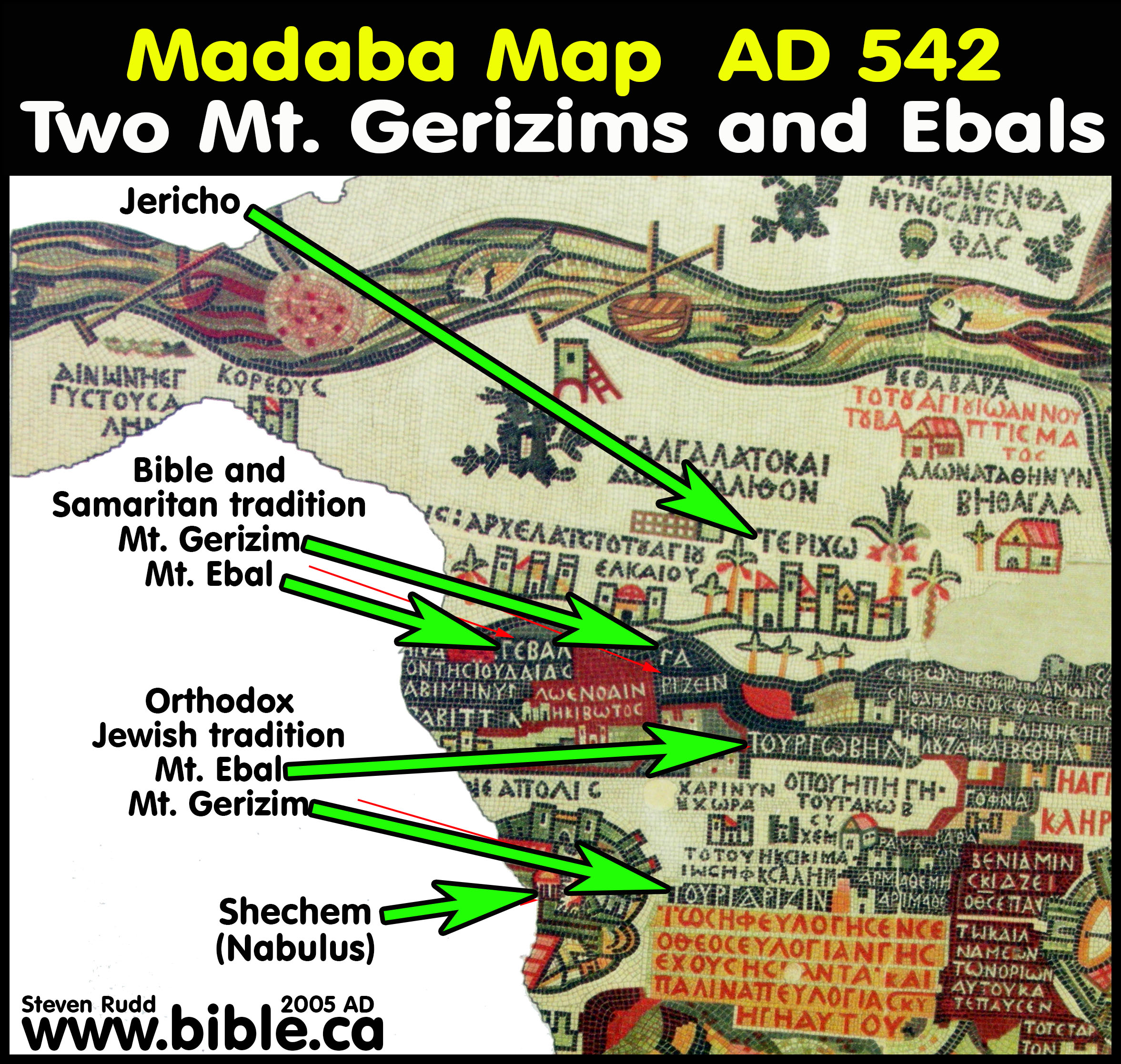
f.
Even today Jews believe the Samaritans have chosen the wrong location
for Mt. Gerizim. The
author, while excavating “Joshua’s Altar”, took this photograph as Adam
Zertal standing on Mt. Ebal, said the mountain behind him to the east was the
true location of Mt. Gerizim. He has also published this view.
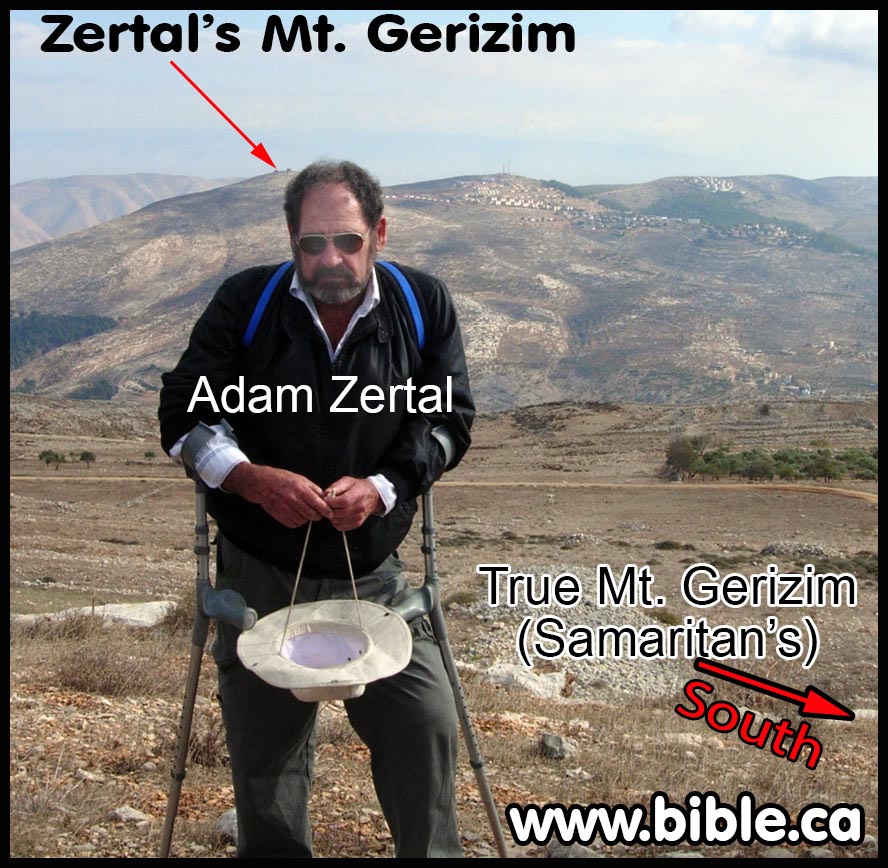
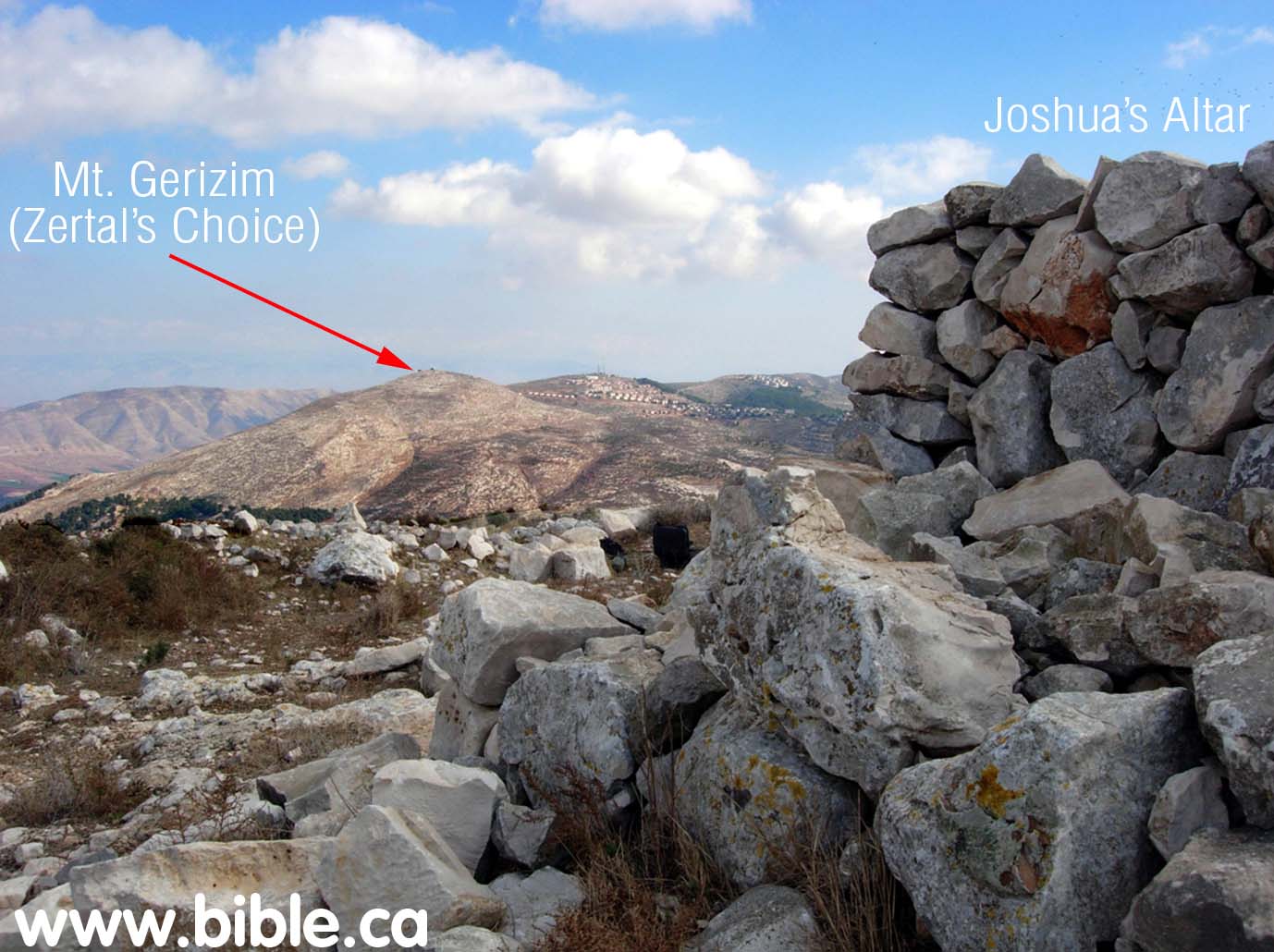
g. All these changes predated the translation of the Septuagint in 282 BC which along with the Masoretic text, contain these minor and insignificant “anti-Samaritan” corruptions to the present day.
26. 458 BC: Begin 70 weeks of Daniel 9:14:
a. Ezra 7:8: Decree to rebuild Jerusalem in 7th year of Artaxerxes I.
b. 490 years to 3 April 33 AD.
c. Daniel’s 70 weeks is exactly 490 years from 458 BC – 33 AD and ends at the cross.
d.
Premillennialists who “stop the clock” at week 69 for a
pause that has lasted for 2000 years, get the starting time wrong but should
just be slapped out of their silliness, or stated in a more academic way, they
should “reconsider their extemporizations”, especially since pre-tribulation
rapture doctrine was invented by John Darby in 1830 AD.

27. 458 BC: Ezra was the resident expert on the Law of Moses with his brand new “Aramaic Hebrew” bible manuscripts
a. "This Ezra went up from Babylon, and he was a scribe skilled in the law of Moses, which the Lord God of Israel had given; and the king granted him all he requested because the hand of the Lord his God was upon him. Some of the sons of Israel and some of the priests, the Levites, the singers, the gatekeepers and the temple servants went up to Jerusalem in the seventh year of King Artaxerxes. He came to Jerusalem in the fifth month, which was in the seventh year of the king. For on the first of the first month he began to go up from Babylon; and on the first of the fifth month he came to Jerusalem, because the good hand of his God was upon him. For Ezra had set his heart to study the law of the Lord and to practice it, and to teach His statutes and ordinances in Israel." (Ezra 7:6–10)
28. 445 BC: Neh 6:5: Jerusalem City walls rebuilt
a. Nehemiah is appointed governor
b. Nehemiah begins and completes rebuilding the walls of Jerusalem in a few months.
c. Sanballat is the governor of the Samarians at Shechem
d. Tobiah and Samaritan governor Sanballat forces a work stoppage of Nehemiah
e. Josephus records how the Samaritans resisted Nehemiah:
i. “But when the Samaritans, who were still enemies to the tribes of Judah and Benjamin, heard the sound of the trumpets, they came running together, and desired to know what was the occasion of this tumult; and when they perceived that it was from the Jews who had been carried captive to Babylon, and were rebuilding their temple, they came to Zorobabel and to Jeshua, and to the heads of the families, and desired that they would give them leave to build the temple with them, and to be partners with them in building it; for they said, (85) “We worship their God, and especially pray to him, and are desirous of their religious settlement, and this ever since Shalmanezer, the king of Assyria, transplanted us out of Cuthah and Media, to this place.” (86) When they said thus, Zorobabel, and Jeshua the high priest, and the heads of the families of the Israelites, replied to them, that it was impossible for them to permit them to be their partners, whilst they [only] had been appointed to build that temple at first by Cyrus, and now by Darius, (87) although it was indeed lawful for them to come and worship there if they pleased, and that they could allow them nothing, but that in common with them, which was common to them with all other men, to come to their temple and worship God there. 4. (88) When the Cetheans heard this, for the Samaritans have that appellation, they had indignation at it, and persuaded the nations of Syria to desire of the governors, in the same manner as they had done formerly in the days of Cyrus, and again in the days of Cambyses afterwards, to put a stop to the building of the temple, and to endeavor to delay and protract the Jews in their zeal about it.” (Josephus Antiquities 11.83–88)
ii. “Now Darius, when the Samaritans had written to him, and in their epistle had accused the Jews how they fortified the city, and built the temple more like to a citadel than a temple; and said, that their doings were not expedient for the king’s affairs; and besides, they showed the epistle of Cambyses, wherein he forbade them to build the temple: (98) and when Darius thereby understood that the restoration of Jerusalem was not expedient for his affairs, and when he had read the epistle that was brought him from Sisinnes and those that were with him, he gave order that what concerned these matters should be sought for among the royal records.—(99) Whereupon a book was found at Ecbatana, in the tower that was in Media, wherein was written as follows:—“Cyrus the king, in the first year of his reign commanded that the temple should be built in Jerusalem; and the altar in height threescore cubits, and its breadth of the same, with three edifices of polished stone, and one edifice of stone of their own country; (100) and he ordained that the expenses of it should be paid out of the king’s revenue. He also commanded that the vessels which Nebuchadnezzar had pillaged [out of the temple], and had carried to Babylon, should be restored to the people of Jerusalem” (Josephus Antiquities 11.97–100)
iii. “But now when the Ammonites, and Moabites,and Samaritans, and all that inhabited Celesyria, heard that the building went on apace, they took it heinously, and proceeded to lay snares for them, and to hinder their intentions. (175) They also slew many of the Jews, and sought how they might destroy Nehemiah himself, by hiring some of the foreigners to kill him. They also put the Jews in fear, and disturbed them, and spread abroad rumors, as if many nations were ready to make an expedition against them, by which means they were harassed, and had almost left off the building. (176) But none of these things could deter Nehemiah from being diligent about the work; he only set a number of men about him as a guard to his body, and so unweariedly persevered therein, and was insensible of any trouble out of his desire to perfect this work. And thus did he attentively, and with great forecast, take care of his own safety; not that he feared death, but of this persuasion, that if he were dead, the walls, for his citizens, would never be raised.” (Josphus Antiquities 11.174–176)
29. 333 BC: Large number of Samaritans deported to Alexandria Egypt:
a. Large number of Samaritans were settled in Alexandria, Egypt before the translation of the Septuagint:
b. “This is what Agatharchides relates of our nation. But when [general] Ptolemy had taken a great many captives, both from the mountainous parts of Judea and from the places about Jerusalem and Samaria, and the places near Mount Gerizim, he led them all into Egypt, and settled them there. (8) And as he knew that the people of Jerusalem were most faithful in the observation of oaths and covenants; and this formed the answer they made to Alexander, when he sent an embassage to them, after he had beaten Darius in battle; so he distributed many of them into garrisons, and at Alexandria gave them equal privileges of citizens with the Macedonians themselves; and required of them to take their oaths that they would keep their fidelity to the posterity of those who committed these places to their care. (9) Nay, there were not a few other Jews who, of their own accord, went into Egypt, as invited by the goodness of the soil, and by the liberality of Ptolemy. (10) However, there were disorders among their posterity, with relation to the Samaritans, on account of their resolution to preserve that conduct of life which was delivered to them by their forefathers, and they thereupon contended one with another, while those of Jerusalem said that their temple was holy, and resolved to send their sacrifices thither; but the Samaritans were resolved that they should be sent to Mount Gerizim.” (Josephus Antiquities 12.7–10)
c. If is obvious that the Samaritan Temple on Mt. Gerizim was in full operation AT THE TIME Alexander’s army general, Ptolemy I, deported them to Alexandria.
30. 333-323 BC: Samaritan temple on Mt. Gerizim rebuilt and enlarged:
a. Josephus says the Samaritan temple was built/rebuilt/renovated/expanded during the time of Alexander the Great: 333-323: “Now it came to pass that the Alexandrian Jews, and those Samaritans who paid their worship to the temple that was built in the days of Alexander at Mount Gerizzim, did now make a sedition one against another, and disputed about their temples before Ptolemy himself, the Jews saying that, according to the law of Moses, the temple was to be built at Jerusalem; and the Samaritans saying that it was to be built at Gerizzim. … And these were the events that befell the Jews at Alexandria in the days of Ptolemy [IV] Philometor.” (Josephus Antiquities 13.74–79, 222-204 BC)
b. Archeological work and other literary sources show that Josephus was wrong either wrong or we are misunderstanding what he means when he says the Samaritan temple was first built around 333 BC.
c. However Josephus may be referring to a refurb or a rebuild, similar to how Herod the Great rebuilt the Jewish temple in 18 BC.
d. Josephus Antiquities 12.7–10 confirms the that the temple was refurbed in some way because in 333 BC (see above) when Alexander the Great deported the Samaritans, there were immediate demands that their money be sent to the Mt. Gerizim temple NOT the Jerusalem temple.
e. It seems that Alexander the Great wanted to appease the Samaritans and sent money to rebuild or refurbish the Mt. Gerizim synagogue.
31. 282 BC: The Septuagint Torah is translated from the Aramaic (square) Hebrew manuscript:
a. 170 years after Ezra converted/translated/corrupted the Paleo-Hebrew Torah, the Jews in Jerusalem were now copying and using Ezra’s manuscripts.
b. The 70 Jewish translators came from Jerusalem with a “High priest” certified correct copy of the Torah to Alexandria Egypt in 282 BC.
c. The Greek Septuagint was translated from the Hebrew “Aramaic Hebrew” manuscripts of Ezra in Jerusalem.
d. The author has excavated what Adam Zertal wrongly called “Joshua’s Alter” on Mt. Ebal. The Altar is clearly Hebrew but it is not oriented east and dates to 1250 BC, which is 150 years too late.
e. The Samaritans not only had their own functioning temple on Mt. Gerizim at the time the LXX was translated, the Samaritans also had an original Paleo-Hebrew copy of the Torah. There must have been open discussions between the two groups regarding the variants that existed between the existing Hebrew text in Jerusalem AND the perfect and untouched Samaritan Pentateuch in 282 BC.
f. Just like Augustine in 400 AD wrongly gave the Jews the benefit of the doubt regarding the fact they corrupted their Torah Chronology in Gen 5,11 for anti-Christians theological reasons, (counter to the prevailing opinion of the day that the Jews did corrupt the text), so too the translators of the Septuagint simply could not accept that Ezra had corrupted the Torah which originally said that Joshua’s alter was built on Mt. Gerizim… exactly like it read in the paleo-Hebrew Torah that Josiah gave to the Samaritans in 623 BC. Although Augustine rejected the idea that the Jews corrupted their chronologies in Gen 5,11, he takes specific note that was a widely held opinion of the day. Augustine was wrong and the prevailing opinion that the Jews changed their Torah chronology was true.
g. This explains why both the LXX and Masoretic text today contain the corruption that Joshua’s alter was built on Mt. Ebal instead of Mt. Gerizim in the original. Joshua clearly built his alter on Mt. Gerizim not Mt. Ebal the mountain of curses.
32. 250 BC: Samaritan Synagogue: In 250 BC, the Samaritans built one of the earliest synagogues known to exist.
a.
See also: The Synagogue
on Delos Island in Greece
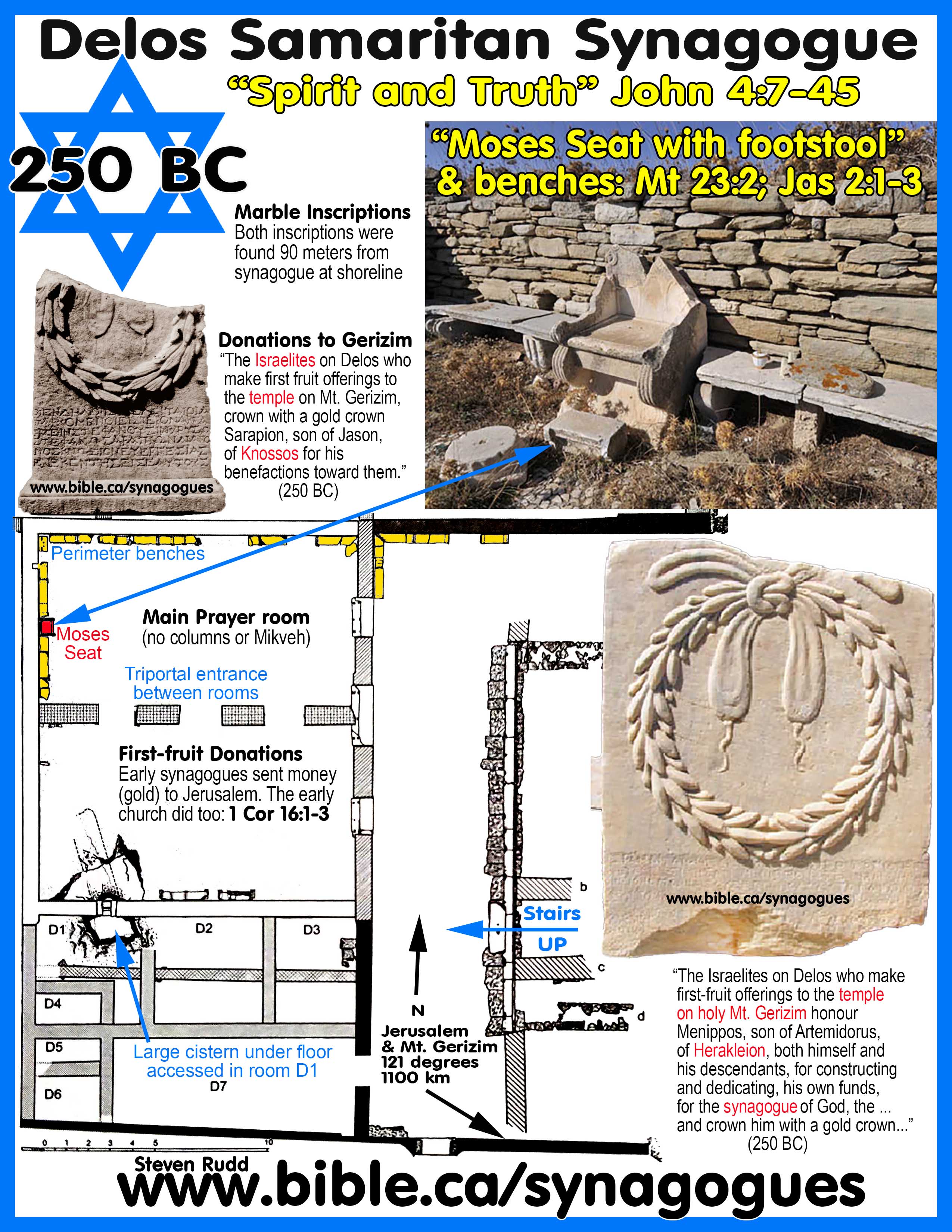
b. The two Delos synagogue inscriptions were found 100 meters from the synagogue on the seashore.
c.
The text of the two Delos inscriptions shows how the worshippers were in
the habit of collecting synagogue money and sending it to the Samaritan temple
on Mt. Gerizim.

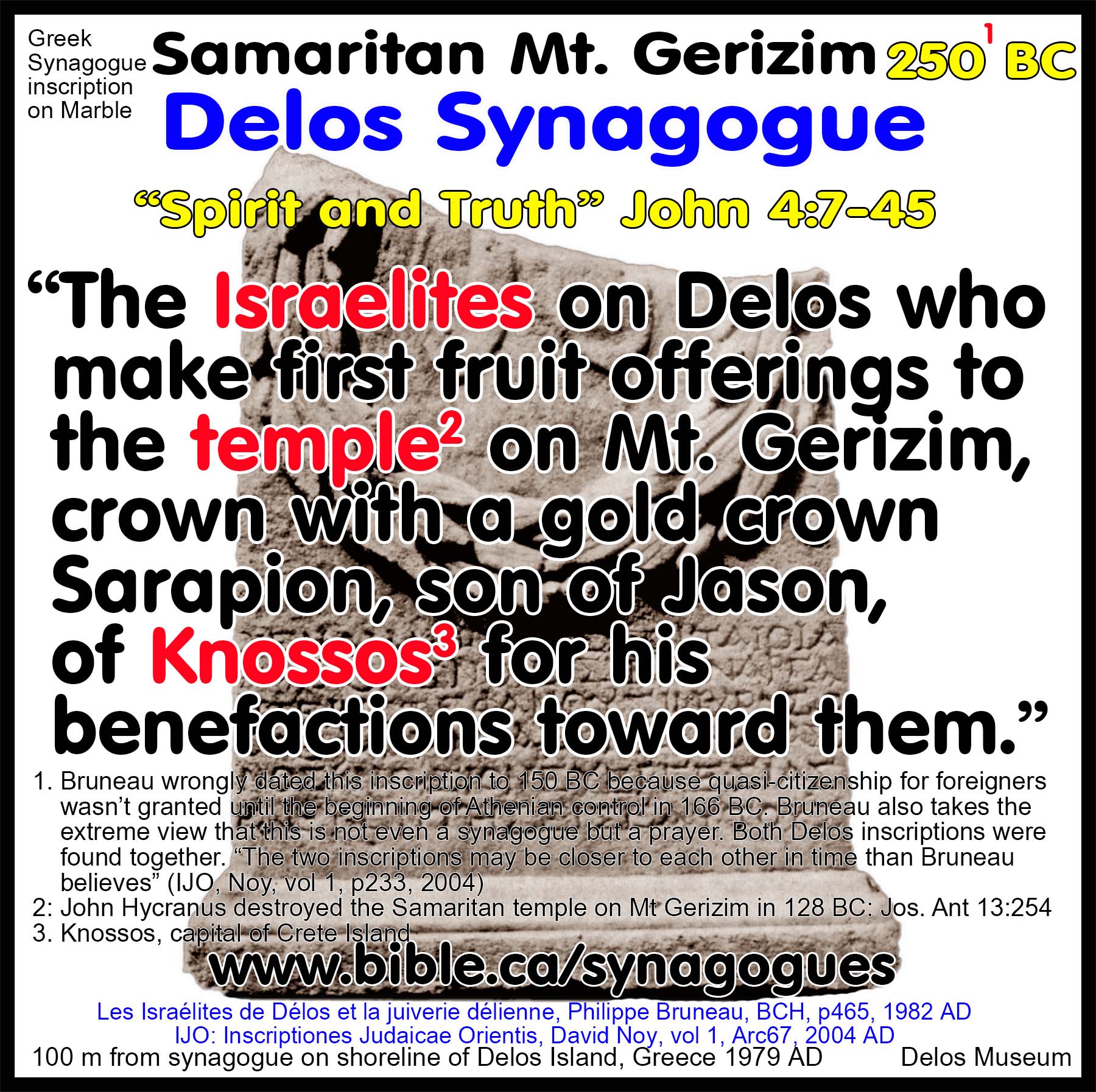
33. 150 BC: Samaritans begin to make three kinds of changes in the Samaritan Pentateuch:
a. Some changes were irrelevant in the overall picture
b. Replicated scripture into new locations:
i. Some changes were mere additions of Bible text from one place to another.
ii. Additional text in the Ten commandments in Ex 20 and Deut 5 is a good example.
iii. No new scripture is created. Instead they borrowed a quote from another place and replicated it at a new location in the Torah so the same identical reading was found twice.
c. Corruption of the Gen 11 chronology:
i. The chronological numbers in the Samaritan Pentateuch are in a world of their own. Nothing in history is known to agree with the numbers.
ii. The reasons why the Samaritans change these Chronological numbers from Shem to Abraham are a mystery.
34. 111 BC: Destruction of the Samaritan temple in 111 BC by John Hycranus:
a. “But when Hyrcanus heard of the death of Antiochus he presently made an expedition against the cities of Syria, hoping to find them destitute of fighting men, and of such as were able to defend them. (255) However, it was not till the sixth month that he took Medaba, and that not without the greatest distress of his army. After this he took Samega, and the neighboring places; and, besides these, Shechem and Gerizzim, and the nation of the Cutheans, (256) who dwelt at the temple which resembled that temple which was at Jerusalem, and which Alexander permitted Sanballat, the general of his army, to build for the sake of Manasseh, who was son-in-law to Jadua the high priest, as we have formerly related; which temple was now deserted two hundred years after it was built.” (Josephus Antiquities 13.254–256)
b. “At the time when Stephen was said to have delivered his address, the Gerizim temple had been lying in ruins for a century and a half.” (The Samaritans: A Profile, R. Pummer, p 44, 2016 AD)
c. “According to Josephus, the Gerizim temple was destroyed two hundred years after it had been built in the time of Alexander the Great. The event happened in the course of the Hasmonean king John Hyrcanus I’s conquests in Syria (War 16:62–63 and Ant. 13:254–256), as Josephus recounts: John Hyrcanus captured “Shechem and Garizein and the Cuthaean nation, which lives near the temple built after the model of the sanctuary at Jerusalem, which Alexander permitted their governor Sanaballetes to build for the sake of his son-in-law Manasses, the brother of the high priest Jaddua, as we have related before” (Ant. 13:255–256). In the introduction to this passage, Josephus dates the event in the year 130 or 129 b.c.e., and in the conclusion of his account in Antiquities he adds that it was laid waste two hundred years after it was built. However, we will see in the section on archaeology that excavations on Mt. Gerizim—especially coin finds—have shown that the destruction must be dated later, that is, in 111 or 110 b.c.e. In contrast to the narrative about the building of the temple, Josephus’s report about its end is very short; no mention of John Hyrcanus’s motive is made. Nor does Josephus even hint at the impact of Hyrcanus’s actions on the Samaritans and on the relationship between the latter and the Jews.” (The Samaritans: A Profile, R. Pummer, p 61, 2016 AD)
d. Archeological work and other literary sources show that Josephus was referring to a rebuild of the Samaritan temple around 333 BC, similar to how Herod the Great rebuilt the Jewish temple in 18 BC but it had existed since 967 BC.
35. 30 AD: The Samaritans in the New Testament:
a. We have the parable of the Good Samaritan and the mass conversion of the Samaritans at Shechem via the woman at the well of John 4 and then the conversion of the Samaritans by Philip, Simon the sorcerer in Acts 8
b. Contrast in the conversion of the Samaritans vs. the resistance of the Jews:
i. “The Gospel’s interest is, however, not in the Samaritans as such nor in the disputes between Jews and Samaritans. Rather, the Samaritans serve as a foil to the former—in the course of the Gospel, the Jews oppose Jesus more and more, whereas the Samaritans accept Jesus’ message. Moreover, the traces of the conflict between Jews and Samaritans in this passage are obfuscated by the pericope’s intention to highlight Jesus’ position of prophet and messianic teacher. Later in the Gospel of John, Jesus is accused by the Jews of being a Samaritan and being possessed by a demon (John 8:48). This is the only place in the New Testament where “Samaritan” and “demon” are used together, and nowhere is “Samaritan” a term of abuse.” (The Samaritans: A Profile, R. Pummer, p 43, 2016 AD)
ii. The success of Jesus among the Samaritans did not go unnoticed: "The Jews answered and said to Him, “Do we not say rightly that You are a Samaritan and have a demon?”" (John 8:48)
36. 67 AD: 11,600 Samaritans at Mt. Gerizim are killed by the Romans:
a. “In July 67 c.e. the Samaritans clashed once more with the Romans (War 3:307–315). They gathered on Mt. Gerizim and “did not move from the spot.” Their unbending stance aroused in the minds of the Romans the suspicion that the Samaritans might intend to revolt. To forestall such an action, Emperor Vespasian sent a large number of cavalry (600 combatants) and infantry (3,000 combatants) to the area, led by the commander of the fifth legion, Sextus Cerealis Vettulenus. Due to the strength of the assembled Samaritans, Cerealis considered it more prudent to surround the base of the mountain with his troops and wait until the Samaritans would surrender. His calculations proved right. Not all Samaritans surrendered, but some died of thirst and others deserted to the Romans on the first day. A formidable heat wave—it was midsummer—found the Samaritans without provisions. Cerealis realized that the rest must also be exhausted, ascended the mountain and invited the Samaritans to capitulate. When they refused, he attacked and killed all of them, 11,600 in all.” (The Samaritans: A Profile, R. Pummer, p 64, 2016 AD)
b. “Nor did the Samaritans escape their share of misfortunes at this time; for they assembled themselves together upon the mountain called Gerizzim, which is with them a holy mountain, and there they remained; which collection of theirs, as well as the courageous minds they showed, could not but threaten somewhat of war; (308) nor were they rendered wiser by the miseries that had come upon their neighboring cities. They also, notwithstanding the great success the Romans had, marched on in an unreasonable manner, depending on their own weakness, and were disposed for any tumult upon its first appearance. (309) Vespasian therefore thought it best to prevent their motions, and to cut off the foundation of their attempts; for although all Samaria had ever garrisons settled among them, yet did the number of those that were come to mount Gerizzim, and their conspiracy together, give ground to fear what they would be at; (310) he therefore sent thither Cerealis, the commander of the fifth legion, with six hundred horsemen and three thousand footmen, (311) who did not think it safe to go up to the mountain and give them battle, because many of the enemy were on the higher part of the ground; so he encompassed all the lower part of the mountain with his army, and watched them all that day. (312) Now it happened that the Samaritans, who were now destitute of water, were inflamed with a violent heat (for it was summertime, and the multitude had not provided themselves with necessaries), (313) insomuch that some of them died that very day with heat, while others of them preferred slavery before such a death as that was, and fled to the Romans, (314) by whom Cerealis understood that those who still stayed there were very much broken by their misfortunes. So he went up to the mountain, and having placed his forces round about the enemy, he, in the first place, exhorted them to take the security of his right hand, and come to terms with him, and thereby save themselves; and assured them, that if they would lay down their arms, he would secure them from any harm; (315) but when he could not prevail with them, he fell upon them and slew them all, being in number eleven thousand and six hundred. This was done on the twenty-seventh day of the month Desius [Sivan]. And these were the calamities that befell the Samaritans at this time.” (Josephus Wars 3.307–315)
37.
1865 AD: Photo of
Joseph’s tomb in 1865 and 1894 AD. (Zvi Ilan, Tombs of the Righteous in the
Land of Israel, p. 365)
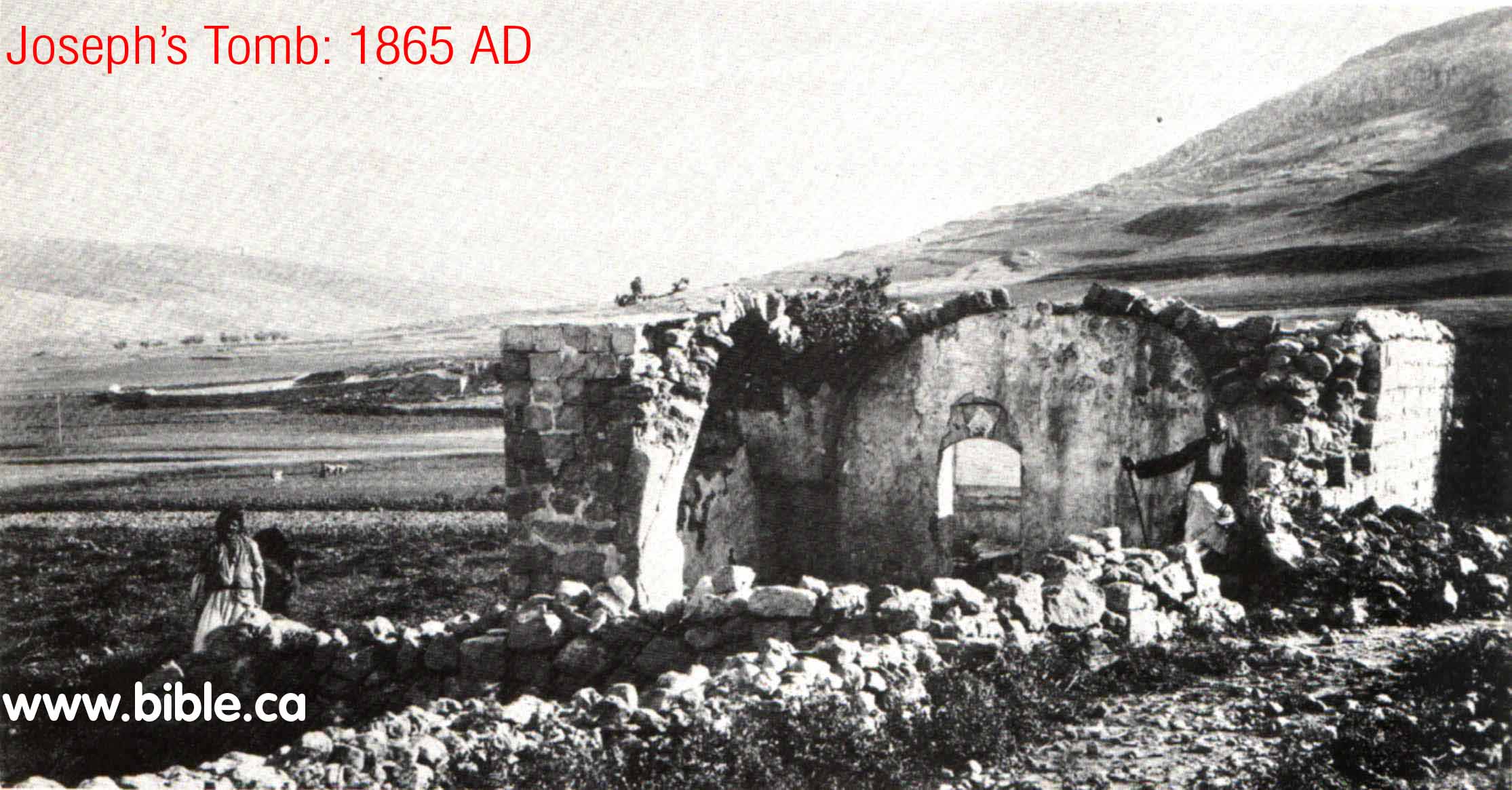 .
.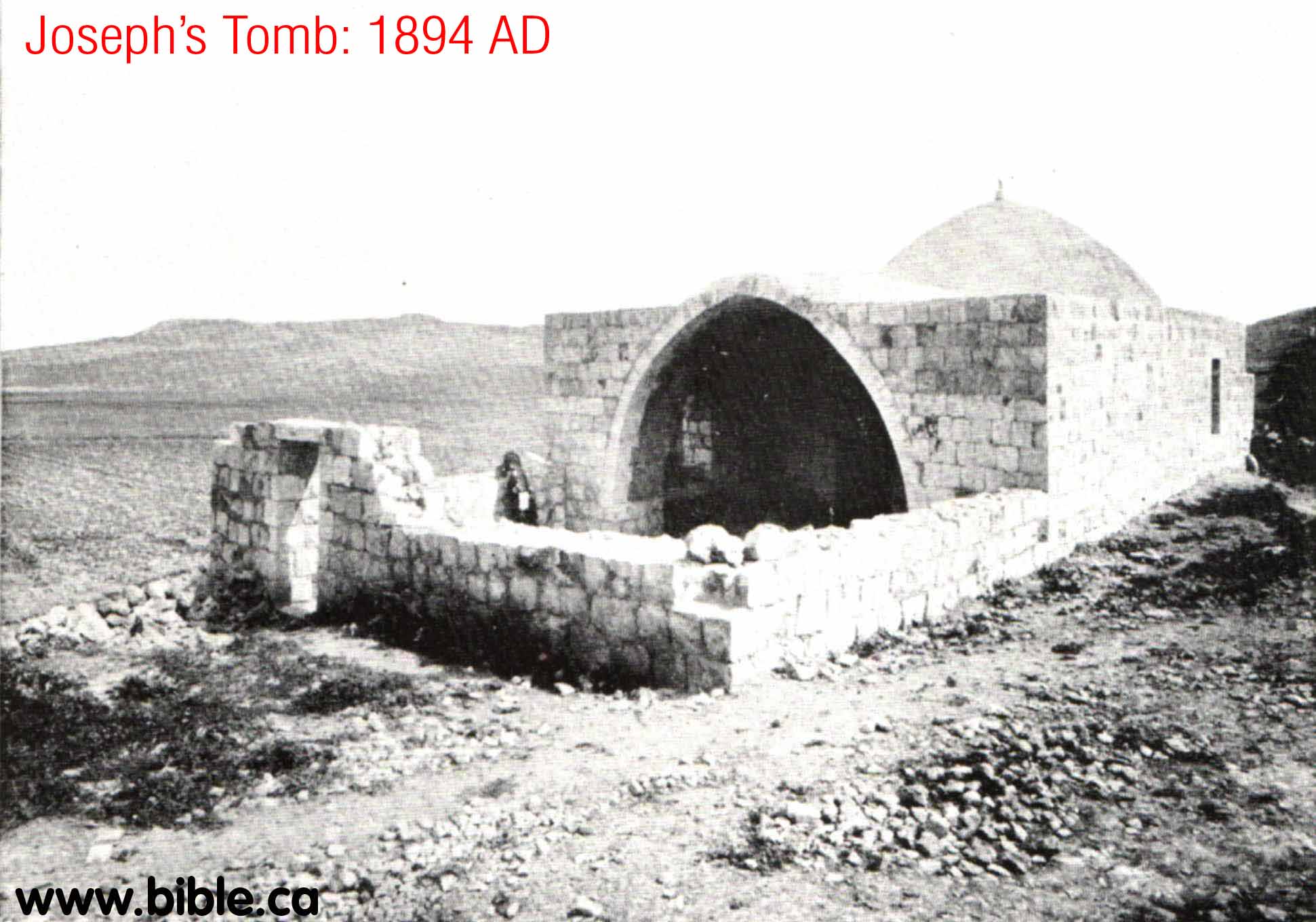
38.
7 October 2000, Joseph's
Tomb, the third most holy place in Judaism, was destroyed by Muslims. It is
located east of modern Nabulus between Shechem (Tel Balata) and Sychar at the
foot of Mt. Ebal. It had come under attack and the Israeli Defense Forces (IDF)
withdrew after gaining reassurances from the Palestinian Authority (PA) that they
would protect the site in accordance with their obligations under the Oslo
Accords to protect holy sites. Two hours after the withdrawal Muslims began
destroying the site. It was burned and torn down stone by stone, then
bulldozed. It was immediately declared a Muslim holy site.

39.
Today, ancient Shechem is located Tel Balata, which is
about 3 km east of modern Nabulus. It may be that Tel Balata which literally
means "a paving stone or tile" may in fact derive from Arabic balut,
meaning "oak".

a.
Today, the tomb of Joseph is located east of
modern Nabulus between Tel Balata and Sychar: "one of the tombs whose
location is known with the utmost degree of certainty and is based on
continuous documentation since biblical times.
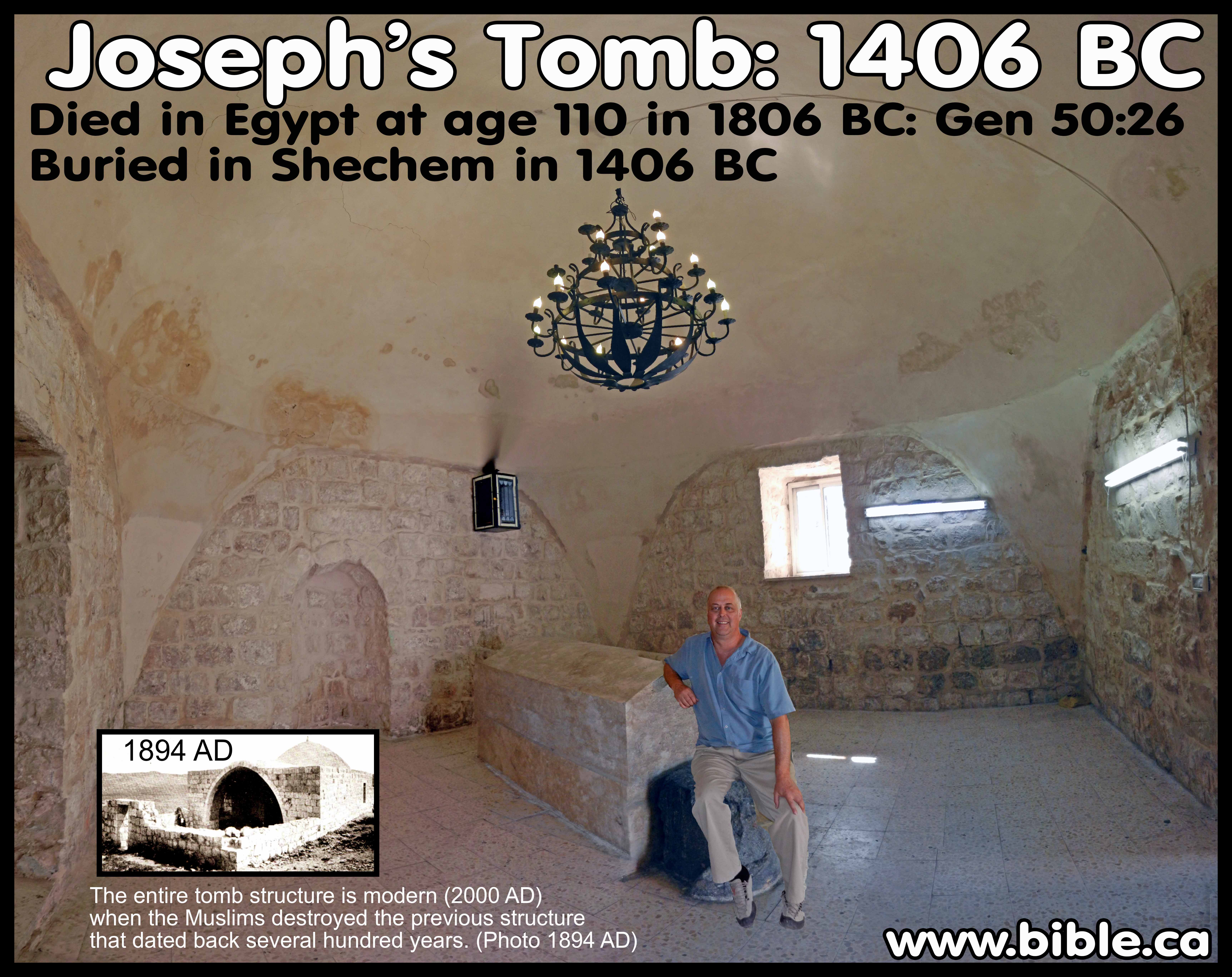
II. Three phases of Samaritan ideology:
1. The origin of Samaritans ideology is Jeroboam: Incubation stage: 931-723 BC
a. The "Incubation stage" of Samaritan history is from the time of the divided kingdom to the time of the Assyrian captivity. (931-723 BC)
b. The history of the Samaritans starts with Solomon's son Rehoboam who went to Shechem to become king: "Then Rehoboam went to Shechem, for all Israel had come to Shechem to make him king." (1 Kings 12:1). Since Solomon was anointed king at the Gihon spring (1 Kings 1:33)
c. Rehoboam acted foolishly and caused the Kingdom to split in two. The ten northern tribes became the Kingdom of Israel under King Jeroboam.
d.
About 931 BC, Jeroboam deliberately created a
counterfeit replica of the religion Moses revealed in the Wilderness. He set up
two "Jerusalems": One in Bethel and one in Dan. Here is the worship
site he set up in Dan to compete with the real
Jerusalem. The basic philosophies of the Samaritans where Mt. Gerizim is
the real "holy mountain" not Jerusalem, had their origin in Jeroboam.
This is why we call the Samaritans, "Neo-Jeroboamites".
Jeroboam's famous quote, "Its too far for you to go to Jerusalem",
was the foundation of the Samaritans making Mt. Gerizim as their holy mountain
200 years later.
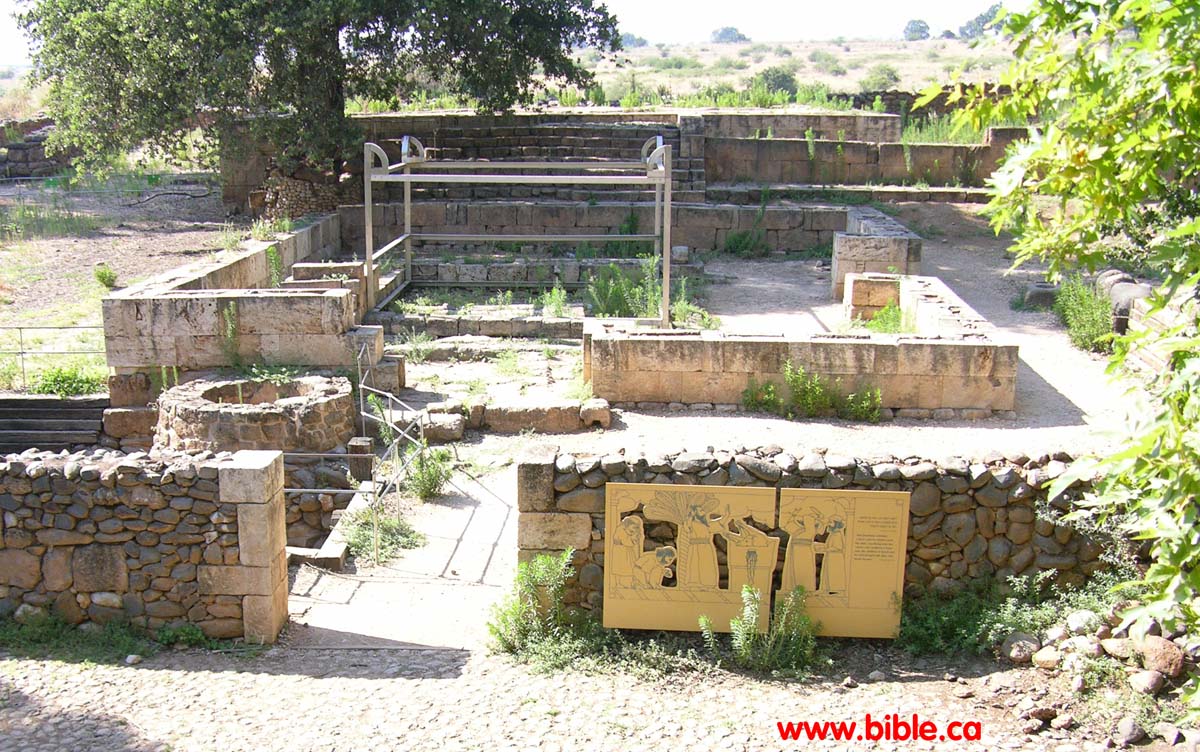
e.
Here is the 3000 year old altar that Jeroboam set up in
Dan. It is the little square of blocks inside the larger replica steel altar.
The area has been rebuilt and enlarged during the Hellenistic period (400 BC).
The Jeroboam's original altar area was expanded and enlarged and included cut
stones with stairs rather than uncut stones with ramps. But Jeroboam's original
altar was found below the newer and larger Hellenistic altar. The steel replica
gives the size and height of the Hellenistic altar that was built over top of
Jeroboam's altar. You can see the 3000 year old male cult oak tree at the rear
right hand side of the photo. Nearby is the 3000 year old female cult myrtle
tree. The oak tree was seen as a male deity and the Myrtle as female deity.
These two tree were part of the pagan worship of the site. Pagan worship under
trees was one of the reasons why the kingdom of Israel went into extinction:
"They set for themselves sacred pillars and Asherim on every high
hill and under every green tree" 2 Kings
17:10
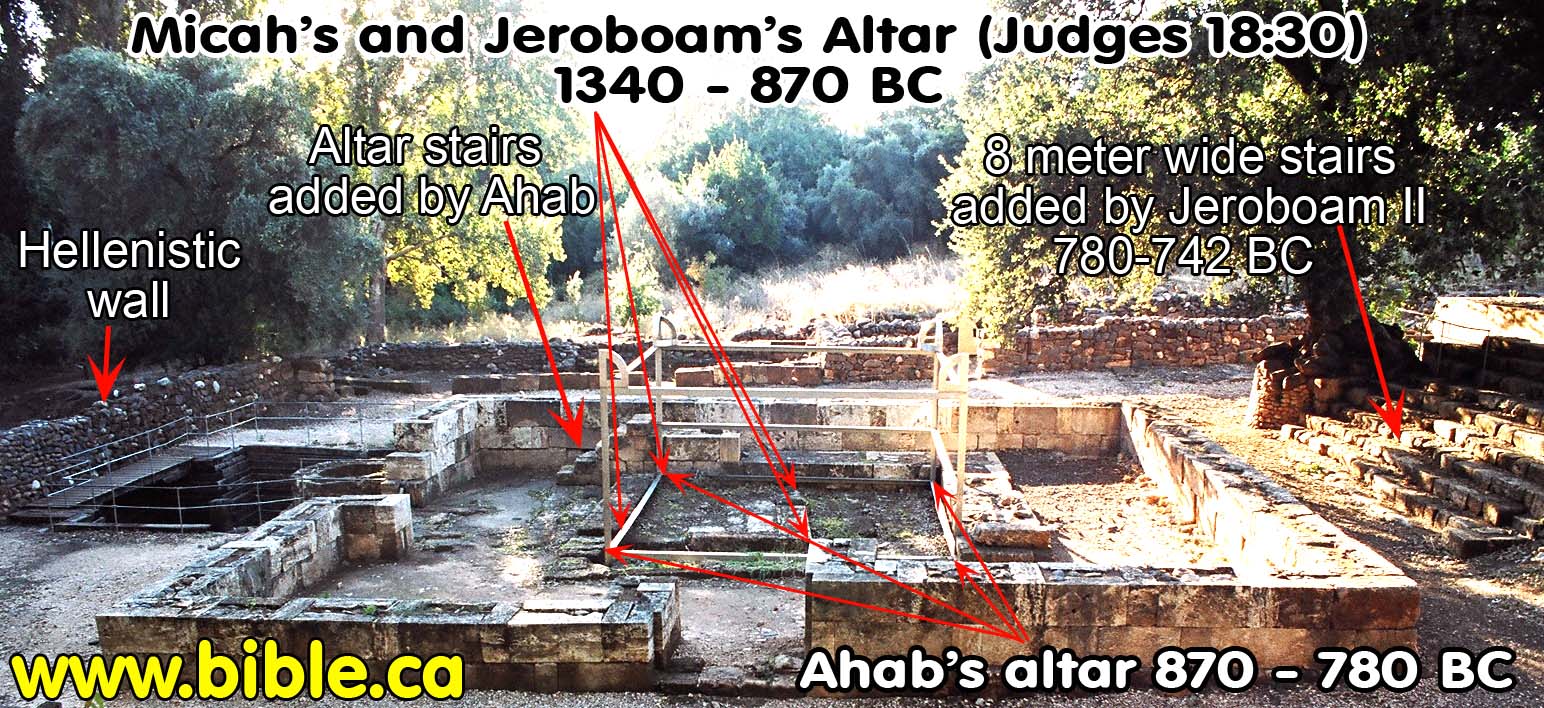
f.
Notice that Shechem, a valley town between Mt. Ebal and
Mt. Gerizim, was Jeroboam's original home base. The Samaritans, influence by
Jeroboam, adopted Shechem as their home base with Mt. Gerizim as their
"real Jerusalem" where Abraham sacrifices Isaac:
"Then Jeroboam built Shechem in the hill country
of Ephraim, and lived there. And he went out from there and built
Penuel. Jeroboam said in his heart, "Now the kingdom will return to the
house of David. "If this people go up to offer sacrifices in the house of
the Lord at Jerusalem, then the heart of this people will return to their lord,
even to Rehoboam king of Judah; and they will kill me and return to
Rehoboam king of Judah." So the king consulted,
and made two golden calves, and he said to them, "It is too much for you
to go up to Jerusalem; behold your gods, O Israel, that brought you up from the
land of Egypt." He set one in Bethel, and the other he put in Dan.
Now this thing became a sin, for the people went to worship before the
one as far as Dan. And he made houses on high places, and made priests from
among all the people who were not of the sons of Levi. Jeroboam instituted a
feast in the eighth month on the fifteenth day of the month, like the feast
which is in Judah, and he went up to the altar; thus he did in Bethel,
sacrificing to the calves which he had made. And he stationed in Bethel the
priests of the high places which he had made. Then he went up to the altar
which he had made in Bethel on the fifteenth day in the eighth month, even in
the month which he had devised in his own heart; and he instituted a feast for
the sons of Israel and went up to the altar to burn incense." 1 Kings
12:25-33
g.
In 723 BC, when the 10 northern tribes (Kingdom of
Israel) went into permanent extinction by being deported into Assyria by
Shalmaneser, the Assyrian king, God blamed Jeroboam for misleading the nation
with his counterfeit religion:
"Now this came about because the sons of Israel had sinned against
the Lord their God, who had brought them up from the land of Egypt from under
the hand of Pharaoh, king of Egypt, and they had feared other gods and walked
in the customs of the nations whom the Lord had driven out before the sons of
Israel, and in the customs of the kings of Israel which they had
introduced. The sons of Israel did things secretly which were not right against
the Lord their God. Moreover, they built for themselves high places in all
their towns, from watchtower to fortified city. They set for themselves sacred
pillars and Asherim on every high hill and under every green tree, and
there they burned incense on all the high places as the nations did which
the Lord had carried away to exile before them; and they did evil things
provoking the Lord. They served idols, concerning which the Lord had said to
them, "You shall not do this thing." Yet the Lord warned Israel and
Judah through all His prophets and every seer, saying, "Turn from
your evil ways and keep My commandments, My statutes according to all the law
which I commanded your fathers, and which I sent to you through My servants the
prophets." However, they did not listen, but stiffened their neck like
their fathers, who did not believe in the Lord their God. They rejected His
statutes and His covenant which He made with their fathers and His warnings
with which He warned them. And they followed vanity and became vain, and went
after the nations which surrounded them, concerning which the Lord had
commanded them not to do like them. They forsook all the commandments of the
Lord their God and made for themselves molten images, even two calves,
and made an Asherah and worshiped all the host of heaven and served Baal. Then
they made their sons and their daughters pass through the fire, and practiced
divination and enchantments, and sold themselves to do evil in the sight of the
Lord, provoking Him. So the Lord was very angry with Israel and removed them
from His sight; none was left except the tribe of Judah. Also Judah did not
keep the commandments of the Lord their God, but walked in the customs which
Israel had introduced. The Lord rejected all the descendants of Israel and
afflicted them and gave them into the hand of plunderers, until He had cast
them out of His sight. When He had torn Israel from the house of David, they
made Jeroboam the son of Nebat king. Then Jeroboam
drove Israel away from following the Lord and made them commit a great sin.
The sons of Israel walked in all the sins of Jeroboam which he did; they did
not depart from them until the Lord removed Israel from His sight, as He spoke
through all His servants the prophets. So Israel was carried away into exile
from their own land to Assyria until this day." 2 Kings 17:7-23
h.
Kermes Oak and
the Scarlet worm: If you look at the photo above,
you can see the male cult Kermes oak tree. Henry Morris talks about the scarlet
worm that fed upon this tree.
Look at the 22nd Psalm. This is the great Psalm of
the crucifixion of Christ written 1,000 years before it was fulfilled. It
describes in great detail the sufferings of Christ on the cross. "My God,
my God, why hast thou forsaken me?" he cries out. Then down in verse
6...he says "But I am a worm, and no man; a reproach of men, and despised
of the people." What did he mean by saying "I am a worm"?...This
particular worm is different from other kinds of worms. There are different
kinds of worms, different varieties, but this is a particular worm. It means
more than just he is not a man. Isaiah 52 says, "his visage was so marred
more than any man, and his form more than the sons of men." He was
literally made corruption personified; he didn't even look like a man there on
the cross; it is talking about more than that here. He says "I am a worm
and no man." This is a scarlet worm and the reason it was called that was
because it had the ability to secrete a scarlet fluid which was used in making
the scarlet dye that they used in ancient days. As a matter of fact, when you
find the word "scarlet" in the bible, it's the same word.
"Though your sins be as scarlet," it's the same word exactly. The
worm was identified with the crimson color. The life cycle of that worm is
something like this: when the mother worm was ready to give birth to the baby
worms, she would find the trunk of a tree, a post or a stick somewhere and then
she would plant her body in that wood and she would implant her body so firmly
in it that she could never leave it again. And then the young would be brought
forth and the mother's body would provide protection for the babies as long as
they needed before they could get out and take care of themselves. Then the
mother would die, and in the process, the scarlet fluid would stain her body
and the body of the young and the tree and so on. The Lord Jesus said "I
am like that scarlet worm." He's making peace through the blood of his
cross; he's bringing many sons into glory through the suffering. And this is a
graphic testimony of the fact that eternal life comes out of the suffering and
death of the Son of God" (Bible & Science tape series, Henry Morris).
The Kermes Oak was historically important as the food plant of the Kermes
insect from which a red dye was obtained and used toward the end of the second
Holy Temple (70 CE). The color red, translated as 'scarlet,' or 'crimson,' in
Hebrew is usually referred to as 'shani' or more fully as 'tolaat shani.' (In
Chronicles, the color is referred to as karmil: "with purple and blue and
crimson yarn", II Chron. 2:6,13). The "scarlet worm", Tola`ath
shani, "scarlet," Cermes vermilio is a scale-insect which feeds upon
the oak and it is not a worm. The female is wingless and adheres to its
favorite plant by its long, sucking beak, by which it extracts the sap on which
it lives. After once attaching itself it remains motionless, and when dead its
body shelters the eggs which have been deposited beneath it. The males, which
are smaller than the females, pass through a complete metamorphosis and develop
wings. The dye is made from the dried bodies of the females. The word 'crimson'
comes from kermes, although the color produced was more of an orange-red. The
Cermes vermilio also gave rise to one other word for red, vermillion (Latin
"worm-colored", from vermiculus, the Latin term for the kermes).
Vermilion, in Hebrew shashar, also appears two times in the Bible (Ezek. 23:14
and Jer. 22:14). This red color was early known; "...and took a scarlet
thread" (Gen 38:2). It was one of the colors of the ephod (Exo 28:6), the
girdle (Exo 28:8), and the breastplate (Exo 28:15) of the high priest. It is
also mentioned in various other connections (Jos 2:18; Sa2 1:24; Lam 4:5; Nah
2:3). A scarlet robe was in mockery placed on our Lord (Mat 27:28; Luk 23:11
Come now, let us reason together," says the LORD. "Though your sins
are like scarlet, they shall be as white as snow; though they are red as
crimson, they shall be like wool (Isa 1:18). Scarlet and crimson were the
firmest of dyes, and thus not easily washed out.

Acorn from a Kermes Oak
2. The Samaritans formally began in 723 -538 BC:
a. 723 - 538 BC: The first phase of Samaritan history is from the time of the divided kingdom to the time of Judah returned from Babylonian captivity in 538 BC. The second phase was after Judah returned from Babylonian captivity.
b. Shalmaneser moved non-Gentile natives of Assyria (Modern Iraq, Babylon) and other places into Samaria to occupy the land to retain control. When God killed these non-Jews with lions the people requested one of the "priests" of Jeroboam's religion, to return and teach them about the "God of the land". Shalmaneser chose one of the priests who was from Bethel to move back into Canaan and educate the gentiles about this God who was killing them. Bethel was one of the two pagan altars that Jeroboam had set up.
c. "The king of Assyria brought men from Babylon and from Cuthah and from Avva and from Hamath and Sephar-vaim, and settled them in the cities of Samaria in place of the sons of Israel. So they possessed Samaria and lived in its cities. At the beginning of their living there, they did not fear the Lord; therefore the Lord sent lions among them which killed some of them. So they spoke to the king of Assyria, saying, "The nations whom you have carried away into exile in the cities of Samaria do not know the custom of the god of the land; so he has sent lions among them, and behold, they kill them because they do not know the custom of the god of the land." Then the king of Assyria commanded, saying, "Take there one of the priests whom you carried away into exile and let him go and live there; and let him teach them the custom of the god of the land." So one of the priests whom they had carried away into exile from Samaria came and lived at Bethel, and taught them how they should fear the Lord. But every nation still made gods of its own and put them in the houses of the high places which the people of Samaria had made, every nation in their cities in which they lived. The men of Babylon made Succoth-benoth, the men of Cuth made Nergal, the men of Hamath made Ashima, and the Avvites made Nibhaz and Tartak; and the Sepharvites burned their children in the fire to Adrammelech and Anammelech the gods of Sepharvaim. They also feared the Lord and appointed from among themselves priests of the high places, who acted for them in the houses of the high places. They feared the Lord and served their own gods according to the custom of the nations from among whom they had been carried away into exile. To this day they do according to the earlier customs: they do not fear the Lord, nor do they follow their statutes or their ordinances or the law, or the commandments which the Lord commanded the sons of Jacob, whom He named Israel; with whom the Lord made a covenant and commanded them, saying, "You shall not fear other gods, nor bow down yourselves to them nor serve them nor sacrifice to them. "But the Lord, who brought you up from the land of Egypt with great power and with an outstretched arm, Him you shall fear, and to Him you shall bow yourselves down, and to Him you shall sacrifice. "The statutes and the ordinances and the law and the commandment which He wrote for you, you shall observe to do forever; and you shall not fear other gods. "The covenant that I have made with you, you shall not forget, nor shall you fear other gods. "But the Lord your God you shall fear; and He will deliver you from the hand of all your enemies." However, they did not listen, but they did according to their earlier custom. So while these nations feared the Lord, they also served their idols; their children likewise and their grandchildren, as their fathers did, so they do to this day." 2 Kings 17:24-41
d. In the end the Hebrew priest of Bethel, who had been trained to function in the false religion Jeroboam invented, learned no lessons from being deported to Assyria. They continued to worship both idols and Yahweh, the one true God of Israel. This is exactly why Yahweh punished them by deporting them for eternal extinction into Assyria.
3. The Samaritans chose Mt. Gerizim after the Babylonian captivity in 538 BC
- 538 BC - 30 AD: The second phase of Samaritan history is from the time Judah returned from Babylonian captivity in 538 BC to the time of Christ's birth.
- After Judah returned from exile, the idol worshipping Samaritans were confronted with a zealous and repentant group of Hebrews who immediately started rebuilding Jerusalem and the Temple. Judah had learned in exile what the Samaritans never did: Follow the word of God exactly as it is written as a blueprint. Many churches today are very "Samaritan like" in that they teach both the Gospel and things that had their origin in the human mind. The biggest false doctrine floating around churches today is: "Doctrine doesn't matter."
- Tobiah (an Ammonite) and the men of Samaritan mocked and opposed Nehemiah's efforts to rebuild Jerusalem: "When Sanballat the Horonite and Tobiah the Ammonite official heard about it, it was very displeasing to them that someone had come to seek the welfare of the sons of Israel." Nehemiah 2:10 "He spoke in the presence of his brothers and the wealthy men of Samaria and said, "What are these feeble Jews doing? Are they going to restore it for themselves? Can they offer sacrifices? Can they finish in a day? Can they revive the stones from the dusty rubble even the burned ones?" Now Tobiah the Ammonite was near him and he said, "Even what they are building-if a fox should jump on it, he would break their stone wall down!"" Nehemiah 4:2-3
- About 515 BC, When the Jews succeeded in
completing rebuilding Jerusalem, Tobiah went off in a huff, and built his
own temple and royal palace, which was located transjordan in his native
homeland of the Ammonites.
The temple can be seen today with amazing full size rock carved lions all
the way around the top of the temple. There are also lions at ground
level. One is pictured below. There are many "house of David"
symbols including lily flowers and capitals of the same style that David
used.
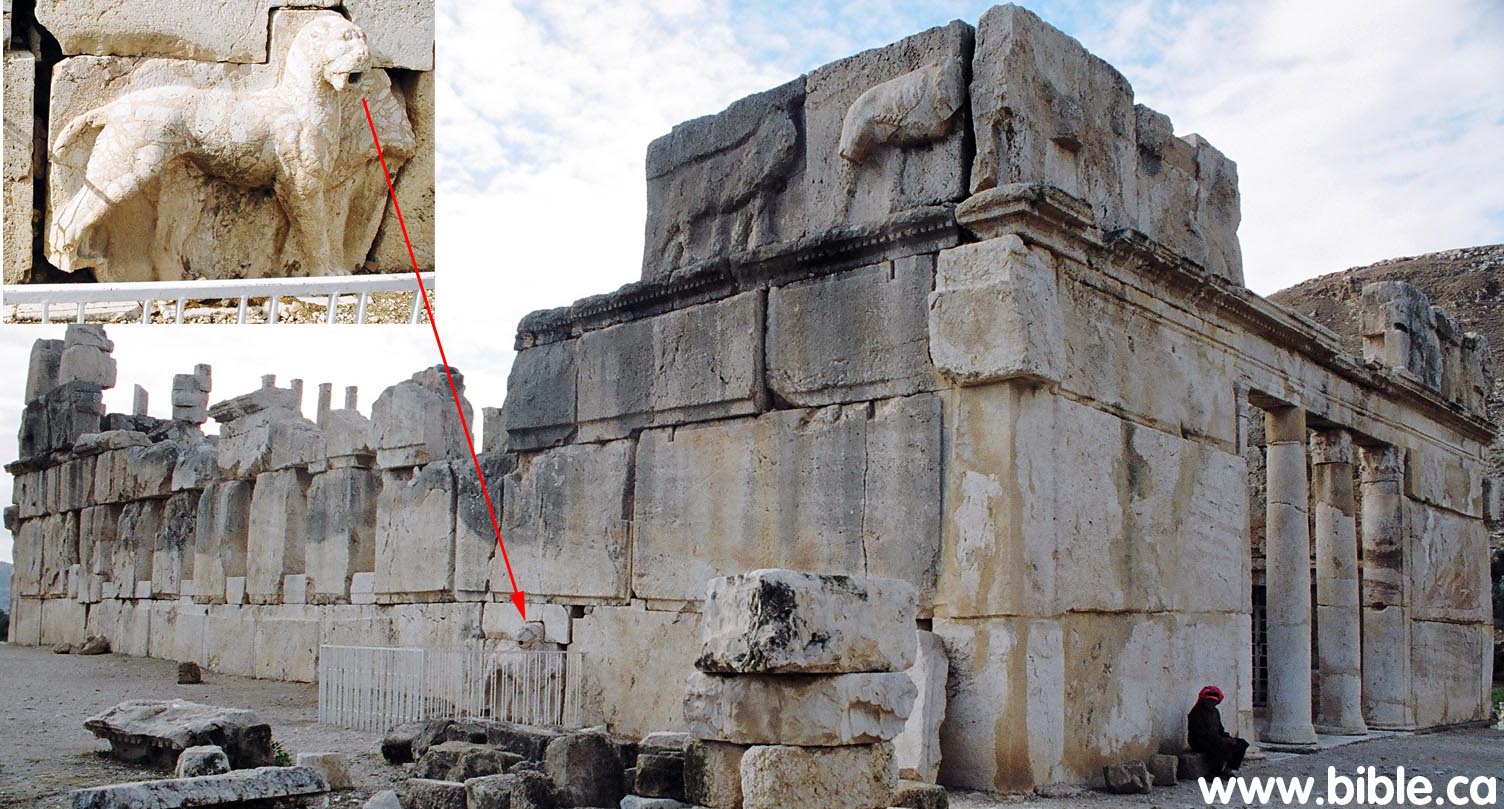
- Tobiah's royal palace was built about 2
kms away up in the side of a rock cliff. It was a massive structure and
twice an inscription can be found on the palace walls that identify it as
"Tobiah". Here is the first "Tobiah" inscription
right of the door that is cut out of solid rock.

- Here is a close up of the second of two
"Tobiah" inscriptions on the palace walls:
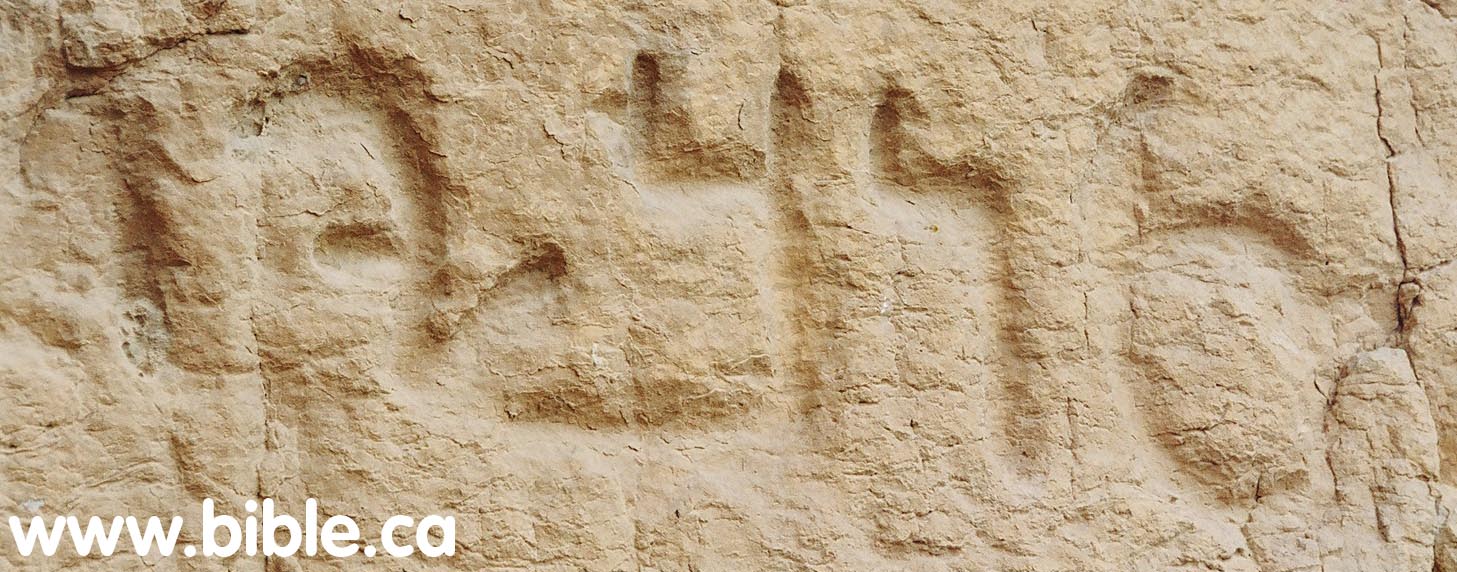
- Here is a more detailed look at Tobiah's temple and palace.
- The arrival of Judah after 538 BC back to Jerusalem was a social force that caused the Samaritan's to get back into the "religious counterfeiting business" of their founder Jeroboam. No doubt they were challenged by this groups of zealous "follow the book, Bible thumping" Judeans. We can hear the Judeans chastising the Samaritans for their continued idolatry. "You never learned your lesson. We have returned back from Babylon and we have learned our lesson. We are not going to worship idols any more. You need to repent. We have the truth, you are worshipping idols still. When will you ever learn?" Of course the Samaritans did not listen, but continued to manufacture lies about Mt. Gerizim being the holy mountain of God, and not Jerusalem.
- Looking back to 931 BC, notice that the first place Jeroboam built a home was at Shechem located in the valley between Mt. Gerizim and Mt. Ebal. The anti-Jerusalem sentiment of Jeroboam is the foundation of what eventually gave birth to the Samaritans who are equally anti-Jerusalem. With the return of Judah from Babylon, the Samaritans were suddenly forced to defend, for the second time, why they would not worship in Jerusalem. Out of this the Samaritans chose Mt. Gerizim as their "Jerusalem".
- Since the grand-daddy and "high priest" of the Samaritans was Jeroboam, it makes sense that they decided to center their religion on a mountain that overlooks their founder's first residence in the valley city of Shechem.
- But they needed to make one more important changes to history. They started teaching that Abraham sacrificed Isaac on Mt. Gerizim, not Mt. Moriah (ie. Jerusalem). So Mt. Gerizim became the "Holy Mountain" of the Samaritans after 538 BC, which was nothing more than a continuation of the ideas Jeroboam had introduced in 931 BC.
- Today the Jews in Israel have irreconcilable differences because Muhammad, like Jeroboam, was a master at myth making and the rewriting of history. For example, Muslims today teach that Moses, Isaiah and Jesus were all Muslims! Being at odds with every history book in every library in every university in the world doesn't seem to be problem for Muslims!
- The true history is that Abraham sacrificed Isaac in Jerusalem. The Samaritans rewrote history and teach Abraham sacrificed Isaac in Mt. Gerizim. The Muslims rewrote history and teach Abraham sacrificed Ishmael in Mecca, Saudi Arabia. In the parable of the Tares, the Devil is the counterfeiter of religion. Today many churches are counterfeits of the true church you read about in the Bible.
- By 500 BC, we have two sects of Jews who have irreconcilable differences in theology because the Samaritans rewrote history into a lie. The Samaritans also intermarried with the gentiles. This is the foundation of the contempt that the Jews have for the Samaritans.
III. How the Jews viewed the Samaritans in 30 AD:
- The Jews at the time of Christ viewed the Samaritans as idol worshipping apostates to be shunned who had intermarried with the Gentiles.
- Not once are the Samaritans referred to as a sect in the Old Testament, Nehemiah 4:2 shows how the "wealthy men of Samaria" mocked Nehemiah's efforts to rebuilt Jerusalem.
- "For Jews have no dealings with Samaritans." John 4:9
- The Jews falsely slandered Jesus for being a Samaritan probably because he was from Nazareth, a city north of Mt. Gerizim. Guilt by geography: "The Jews answered and said to Him, "Do we not say rightly that You are a Samaritan and have a demon?" John 8:48
IV. How Jesus viewed the Samaritans in 30 AD:
1. Jesus' viewed the Samaritans as apostates, just like the rest of Jews did.
a. However, unlike his fellow Jews, Jesus did not shun them.
2. At the early stages of Jesus' ministry he did not view the
Samaritans as being part of Israel but on the same level as Gentiles. This is
important since the Samaritans were originally from the tribes that were part
of the Kingdom of Israel as part of the 10 northern tribes:
"These twelve Jesus sent out after instructing them: "Do not go in the way of the Gentiles, and
do not enter any city of the Samaritans; but rather go to the lost sheep
of the house of Israel." Matthew 10:6
a.
Jesus viewed the Samaritans as foreigners. Of the one
Samaritan leper who Jesus cleansed:
"Were there not ten cleansed? But the nine-where are they? "Was no
one found who returned to give glory to God, except
this foreigner?"" Luke 17:11-18
3. Jesus was rejected by the Samaritans simply because he was on his way to Jerusalem. The bad feelings between the Jews and the Samaritans went both ways:
a. "When the days were approaching for His ascension, He was determined to go to Jerusalem; and He sent messengers on ahead of Him, and they went and entered a village of the Samaritans to make arrangements for Him. But they did not receive Him, because He was traveling toward Jerusalem. When His disciples James and John saw this, they said, "Lord, do You want us to command fire to come down from heaven and consume them?" But He turned and rebuked them, and said, "You do not know what kind of spirit you are of; for the Son of Man did not come to destroy men's lives, but to save them." And they went on to another village." Luke 9:51-56
4. A later time Jesus was making a similar trip to Jerusalem he healed a Samaritan of Leprosy. A miracle like this would surely impact his Samaritan village.
a. "While He was on the way to Jerusalem, He was passing between Samaria and Galilee. As He entered a village, ten leprous men who stood at a distance met Him; and they raised their voices, saying, "Jesus, Master, have mercy on us!" When He saw them, He said to them, "Go and show yourselves to the priests." And as they were going, they were cleansed. Now one of them, when he saw that he had been healed, turned back, glorifying God with a loud voice, and he fell on his face at His feet, giving thanks to Him. And he was a Samaritan. Then Jesus answered and said, "Were there not ten cleansed? But the nine-where are they? "Was no one found who returned to give glory to God, except this foreigner?"" Luke 17:11-18
b. Jesus bluntly told the woman at the well her religion is wrong: "You worship what you do not know; we worship what we know, for salvation is from the Jews." John 4:22
5. In spite of all this, Jesus used a Samaritan as the timeless example of a man doing unconditional good to a stranger in the Parable of the good Samaritan.
6. The Samaritans were included in the great commission: The day Jesus ascended into heaven, Jesus gave three stages of evangelizing the world: "but you will receive power when the Holy Spirit has come upon you; and you shall be My witnesses both in Jerusalem, and in all Judea and Samaria, and even to the remotest part of the earth."" Acts 1:8
a. Jews
b. the Samaritan who were pagan 1/2 Jews
c. The pagan Gentiles
V. The parable of the good Samaritan:
"Jesus replied and said, "A man was going down from Jerusalem to Jericho, and fell among robbers, and they stripped him and beat him, and went away leaving him half dead. "And by chance a priest was going down on that road, and when he saw him, he passed by on the other side. "Likewise a Levite also, when he came to the place and saw him, passed by on the other side. "But a Samaritan, who was on a journey, came upon him; and when he saw him, he felt compassion, and came to him and bandaged up his wounds, pouring oil and wine on them; and he put him on his own beast, and brought him to an inn and took care of him. "On the next day he took out two denarii and gave them to the innkeeper and said, 'Take care of him; and whatever more you spend, when I return I will repay you.' "Which of these three do you think proved to be a neighbor to the man who fell into the robbers' hands?" And he said, "The one who showed mercy toward him." Then Jesus said to him, "Go and do the same."" Luke 10:30-37
- Jesus knew exactly how separate the good honest hearts from the bad in the way He told stories.
- This amazing parable was spoken to a Jewish Lawyer and he made a Samaritan the hero! A Jewish Lawyer was one who is an expert in Mosaic law.
- He used a priest, Levite and a Samaritan. The priest and Levite are vilified and the Samaritan is the hero! Wow how to make your audience hate you! But the honest listener would have to agree.
- In this parable, an expert in Mosaic law, was being told to imitate the morals of a Samaritan who was being held up as a role model.
- It is entirely possible that this was a recent and real news event.
VI. The Samaritan woman at the well converts to Christ:
"There came a woman of Samaria to draw water. Jesus said to her, "Give Me a drink." For His disciples had gone away into the city to buy food. Therefore the Samaritan woman said to Him, "How is it that You, being a Jew, ask me for a drink since I am a Samaritan woman?" (For Jews have no dealings with Samaritans.) Jesus answered and said to her, "If you knew the gift of God, and who it is who says to you, 'Give Me a drink,' you would have asked Him, and He would have given you living water." She said to Him, "Sir, You have nothing to draw with and the well is deep; where then do You get that living water? "You are not greater than our father Jacob, are You, who gave us the well, and drank of it himself and his sons and his cattle?" Jesus answered and said to her, "Everyone who drinks of this water will thirst again; but whoever drinks of the water that I will give him shall never thirst; but the water that I will give him will become in him a well of water springing up to eternal life." The woman said to Him, "Sir, give me this water, so I will not be thirsty nor come all the way here to draw." He said to her, "Go, call your husband and come here." The woman answered and said, "I have no husband." Jesus said to her, "You have correctly said, 'I have no husband'; for you have had five husbands, and the one whom you now have is not your husband; this you have said truly." The woman said to Him, "Sir, I perceive that You are a prophet. "Our fathers worshiped in this mountain, and you people say that in Jerusalem is the place where men ought to worship." Jesus said to her, "Woman, believe Me, an hour is coming when neither in this mountain nor in Jerusalem will you worship the Father. "You worship what you do not know; we worship what we know, for salvation is from the Jews. "But an hour is coming, and now is, when the true worshipers will worship the Father in spirit and truth; for such people the Father seeks to be His worshipers. "God is spirit, and those who worship Him must worship in spirit and truth." The woman said to Him, "I know that Messiah is coming (He who is called Christ); when that One comes, He will declare all things to us." Jesus said to her, "I who speak to you am He." At this point His disciples came, and they were amazed that He had been speaking with a woman, yet no one said, "What do You seek?" or, "Why do You speak with her?" So the woman left her waterpot, and went into the city and said to the men, "Come, see a man who told me all the things that I have done; this is not the Christ, is it?" They went out of the city, and were coming to Him. Meanwhile the disciples were urging Him, saying, "Rabbi, eat." But He said to them, "I have food to eat that you do not know about." So the disciples were saying to one another, "No one brought Him anything to eat, did he?" Jesus said to them, "My food is to do the will of Him who sent Me and to accomplish His work. "Do you not say, 'There are yet four months, and then comes the harvest'? Behold, I say to you, lift up your eyes and look on the fields, that they are white for harvest. "Already he who reaps is receiving wages and is gathering fruit for life eternal; so that he who sows and he who reaps may rejoice together. "For in this case the saying is true, 'One sows and another reaps.' "I sent you to reap that for which you have not labored; others have labored and you have entered into their labor." From that city many of the Samaritans believed in Him because of the word of the woman who testified, "He told me all the things that I have done." So when the Samaritans came to Jesus, they were asking Him to stay with them; and He stayed there two days. Many more believed because of His word; and they were saying to the woman, "It is no longer because of what you said that we believe, for we have heard for ourselves and know that this One is indeed the Savior of the world."" John 4:7-42
- The Samaritan woman at the well resulted in evangelizing the entire Samaritan city. Jesus Disciples are now told to start teaching the Samaritans. This reverses his previous ban on teaching them earlier on in his ministry.
- It is important to keep in mind that Jesus bluntly told the Samaritan woman to her face that her religion was wrong, and yet she was honest enough to accept this and convert to Christ.
- He told her: "You worship what you do not know; we worship what we know, for salvation is from the Jews."
- She could have taken offence, instead she went and brought back the whole town to hear more of this.
VII. Samaritans convert to Christianity:
1. The city of Shechem and Simon the sorcerer become Christians:
a. "Therefore, those who had been scattered went about preaching the word. Philip went down to the city of Samaria and began proclaiming Christ to them. The crowds with one accord were giving attention to what was said by Philip, as they heard and saw the signs which he was performing. For in the case of many who had unclean spirits, they were coming out of them shouting with a loud voice; and many who had been paralyzed and lame were healed. So there was much rejoicing in that city. Now there was a man named Simon, who formerly was practicing magic in the city and astonishing the people of Samaria, claiming to be someone great; and they all, from smallest to greatest, were giving attention to him, saying, "This man is what is called the Great Power of God." And they were giving him attention because he had for a long time astonished them with his magic arts. But when they believed Philip preaching the good news about the kingdom of God and the name of Jesus Christ, they were being baptized, men and women alike. Even Simon himself believed; and after being baptized, he continued on with Philip, and as he observed signs and great miracles taking place, he was constantly amazed. Now when the apostles in Jerusalem heard that Samaria had received the word of God, they sent them Peter and John, who came down and prayed for them that they might receive the Holy Spirit. For He had not yet fallen upon any of them; they had simply been baptized in the name of the Lord Jesus. Then they began laying their hands on them, and they were receiving the Holy Spirit. Now when Simon saw that the Spirit was bestowed through the laying on of the apostles' hands, he offered them money, saying, "Give this authority to me as well, so that everyone on whom I lay my hands may receive the Holy Spirit." But Peter said to him, "May your silver perish with you, because you thought you could obtain the gift of God with money! "You have no part or portion in this matter, for your heart is not right before God. "Therefore repent of this wickedness of yours, and pray the Lord that, if possible, the intention of your heart may be forgiven you. "For I see that you are in the gall of bitterness and in the bondage of iniquity." But Simon answered and said, "Pray to the Lord for me yourselves, so that nothing of what you have said may come upon me." So, when they had solemnly testified and spoken the word of the Lord, they started back to Jerusalem, and were preaching the gospel to many villages of the Samaritans." Acts 8:4-25
- Shechem, the capital city of the Samaritans and Simon the sorcerer are converted. (Although some suggest the city of Samaria was "Sebaste", 11 km NW of ancient Shechem).
- Shechem was converted though the preaching of Philip. Simon the sorcerer, was an example of the type of religion the Samaritans were willing to accept.
- Simon presents a warning to those to follow Pentecostal/Charismatic preachers because:
- Large numbers of people listen to them: "all were giving attention". The fact that large numbers of people supported Simon did not change the fact that he was a fraud. The fact that important people could vouch for him did not change error into truth, or change tricks into miracles.
- The rich, famous and important people follow them: "greatest".
- Long periods of time: "for a long time". (Max Dawson)
- Simon used the same three techniques that modern Pentecostal/Charismatic preachers use to deceive followers into believing they possess supernatural powers:
- Talk: "claiming to be someone great".
- Testimony (of deceived followers): "This man is what is called the Great Power of God."
- Tricks: "he had for a long time astonished them with his magic arts". (Max Dawson)
4. Churches established in Samaritan cities:
a. Churches were established in Samaritan cities: "So the church throughout all Judea and Galilee and Samaria enjoyed peace, being built up; and going on in the fear of the Lord and in the comfort of the Holy Spirit, it continued to increase." Acts 9:31
b. So after 1000 years the Samaritans had finally come home to their God by repenting and believing in Jesus and being baptized for the remission of their sins.
c. The Samaritans who rejected Jesus would share the same fate as the Jews who rejected Jesus: Hell. As far as Christianity is concerned, there is no spiritual difference between a pagan Gentile, a Samaritan and Jew today: They are all lost and need the blood of Jesus in order to be saved and get to heaven. Learn for yourself how to be saved.
VIII. Mt. Gerizim is located next to Shechem and beside the oaks of Moreh:
"The woman said to Him, "Sir, I perceive that You are a prophet. "Our fathers worshiped in this mountain [Gerizim], and you people say that in Jerusalem is the place where men ought to worship." Jesus said to her, "Woman, believe Me, an hour is coming when neither in this mountain nor in Jerusalem will you worship the Father. "You worship what you do not know; we worship what we know, for salvation is from the Jews. "But an hour is coming, and now is, when the true worshipers will worship the Father in spirit and truth; for such people the Father seeks to be His worshipers. "God is spirit, and those who worship Him must worship in spirit and truth."" John 4:19-24
- The Samaritans believed two false doctrines: 1. that Mt. Gerizim was the Holy Mountain of God. 2. The myth that Abraham sacrificed Isaac at Mt. Gerizim instead of Jerusalem as the Bible says.
- Historically, the orthodox Jews who lived in Jerusalem began to claim that the "Mt. Gerizim" Samaritans had chosen, was in fact the wrong mountain. The orthodox Jews knew the Samaritans were at the true Mt. Gerizim, but were wanting to counter their anti-Jerusalem teachings by saying, "You Samaritans claim the Mt. Gerizim is your holy mountain, but you have chosen the wrong mountain for Mt. Gerizim. Obviously then, you are wrong when you say Jerusalem is not the true mountain of God." So the Orthodox invented a new lie to counter the lies of the Samaritans. This was unfortunate because even today in modern Israel, some Jews today continue to claim that the Mt. Gerizim of the Samaritans, is the not the true Mt. Gerizim. The true Mt. Gerizim, is located elsewhere near Jericho and Gilgal." Of course this is a fiction. The Jews were wrong then and they are wrong now. The Samaritans know the correct mountain.
- However the Bible is clear in that Mt. Gerizim is located beside Shechem, not Gilgal: The oaks of Moreh were beside Mt. Gerizim and two Bible verses place the oaks of Moreh beside Shechem (modern Nabulus). (Genesis 12:6 and Genesis 35:4.) Judges 9:7 likewise places Mount Gerizim directly beside Shechem: "Jotham went and stood on the top of Mount Gerizim, and lifted his voice and called out. Thus he said to them, "Listen to me, O men of Shechem, that God may listen to you." (Judges 9:7)
- In 325 AD, Eusebius believed that the Samaritan's choice for Mt. Gerizim was wrong and said so in his Onomasticon which he wrote in 325 AD. He likely based this on the Bible verse that said it was opposite Gilgal: "Are they [Mt. Ebal and Gerizim] not across the Jordan, west of the way toward the sunset, in the land of the Canaanites who live in the Arabah, opposite Gilgal, beside the oaks of Moreh?" Deuteronomy 11:30. It is clear that "opposite Gilgal", does not mean beside Gilgal, as Eusebius claimed. It was beside the oaks of Morah, which was beside Shechem: Genesis 12:6 and Genesis 35:4.
- In 325 AD Eusebius wrongly chose mountains sometimes called "Tyros" and "Thrax" above Aqaba jabr near Jericho. The Samaritans chose "Jebel es-Slamiyeh" and "Jebel et Tur". These are the traditional locations on all Bible maps today and are the correct locations.
- Here is what Eusebius wrote in his Onomasticon
in 325 AD:
Mt. Ebal: "Gaibal (Gebal). Mountain in the Promised Land where Moses commanded an altar to be built (at the command of Moses an alter was built). They say (there are) two neighboring mountains facing each other located at (near) Jericho, one of which (is said) to be Garizin [Gerizim], the other Gaibal [Ebal]. But the Samaritans erroneously point out two others near Neapolis (argue for two mountains near Neapolis but they err greatly) since the great distance of one from the other there shows that they are not able to hear one another when calling out from one (hear the voices calling out in turn blessing or cursing as Scripture records)." (Eusebius, Onomasticon 325 AD) - Mt. Gerizim: "Garizein (Garizin). Mountain where those calling out the blessing (curse) stood. Read the above mentioned Gaibal (Gebal)." (Eusebius, Onomasticon 325 AD)
- Gilgal: "Golgol or Galgal. The Scriptures teach this is near Mt. Garisein and Mt.Gaibal. The place of Galgal is in the Jericho region (near Jericho). [Therefore the Samaritans err who would point out Mt.Gairsin and Mt.Gebal near Neapolis which Scripture testifies are near Galgal.]" (Eusebius, Onomasticon 325 AD)
- Footnote from Onomasticon : This and the following entry can be treated together. The Onomasticon begins by recording the simple biblical information here. The generally accepted tradition is to follow the Samaritan tradition as given here. The two mountains are on either side of Neapolis (K. 4:28) and are Jebel es-Slamiyeh and Jebel et Tur. The Madaba Map reflects this tradition by having them near Shechem (K. 150:1) called Garizin and Gōbel. The pilgrims also recognize this identity. "At Neapolis is Mt Gazaren where the Samaritans say Abraham brought the sacrifice. And to ascend up to the summit are 300 steps. At the foot of the mountain is located a place by the name of Shechem" (Itin. Bourd. PPT I, 18). Zeno and Justinian built churches on Garizein according to Procopius Buildings V, vii, 5-17. Excavation of this area is going on. But Eusebius and Jerome prefer to follow an anti-Samaritan location. The Madaba map hesitates between the two opinions and so locates Gebal Garizeini near Ierichō [Jericho] (K. 104:25). The use of the LXX names in Ierichō region and the Aramaic in the Neapolis area may signify some preference. Since Josephus and the later Byzantines had the correct tradition, this rabbinic tradition must have developed in the late first and early second centuries. Procopius 905C is also confused: "This is situated at the Eastern part of Ierichō beyond Galgal" and he continues by denying the Samaritan tradition. Yet in 908A he seems to accept the Samaritan location and tradition. The two mountains near Jericho are probably those above Aqaba jabr sometimes called Tyros and Thrax. The Roman road to Jerusalem passed between them. In Interpretation of Hebrew Names "Gebal, ancient abyss or stone building" (87). (Eusebius, Onomasticon 325 AD)
- In 542 AD, the Madaba map places the
two mountains twice, in two different locations: On the Madaba map, the
mountains of Ebal and Gerizim are in two different locations. One is at
Shechem (Modern Nabulus) and one near Jericho and Gilgal. This is because
the Orthodox Jews had created a new location near Jericho in their
longstanding dispute with the Samaritans. Eusebius, Jerome and the
creators of the Madaba map were fully aware of the two traditions and
chose to represent both on the map.

- Herbert Donner comments on this: "The mountains Gerizim and Ebal are represented twice on the Madaba Map: near Jericho and near Neapolis. What has happened here? The problem can be solved on the basis of Eus. On. 64:9-14 where, strangely enough, both mountains are indeed located near Jericho. Eusebius, however, does not fail to add: "The Samaritans show other ones near Neapolis, but they are wrong, for the mountains shown by them are too far from each other, so that it is impossible to hear one´s voice when calling to each other." Although this seems to be entirely intelligible and is confirmed by Deut. 27, the Samaritans were by no means wrong. Eusebius was wrong, and everybody knew it, perhaps he himself included. The Samaritans laid claim to the mountains, considering them to be their own holy mountains. Hostility to the Samaritans forced the orthodox Jews in Jerusalem to locate both mountains at another spot, for the Samaritans were not allowed to be right. Eusebius followed the orthodox Jewish tradition. The mosaicist, however, being well informed, preferred a Solomonic solution: he listed the mountains twice, indicating by larger letters that he regarded the location near Nabulus as being correct." (Herbert Donner, The Mosaic Map of Madaba, Kampen 1992, 24.48)
- In the 1980's, Adam Zertal has chosen an
entirely new location for Mt. Gerizim after discovering Joshua's Altar. Zertal
believes the Samaritans chose the wrong mountain in 500 BC this was about
1000 years after Joshua built his altar in 1406 BC. Zertal reasons that
the chances of them getting the mountain wrong is high because of the long
time frame between Joshua and when they first chose Gerizim to be their
"holy mountain". (900 years)
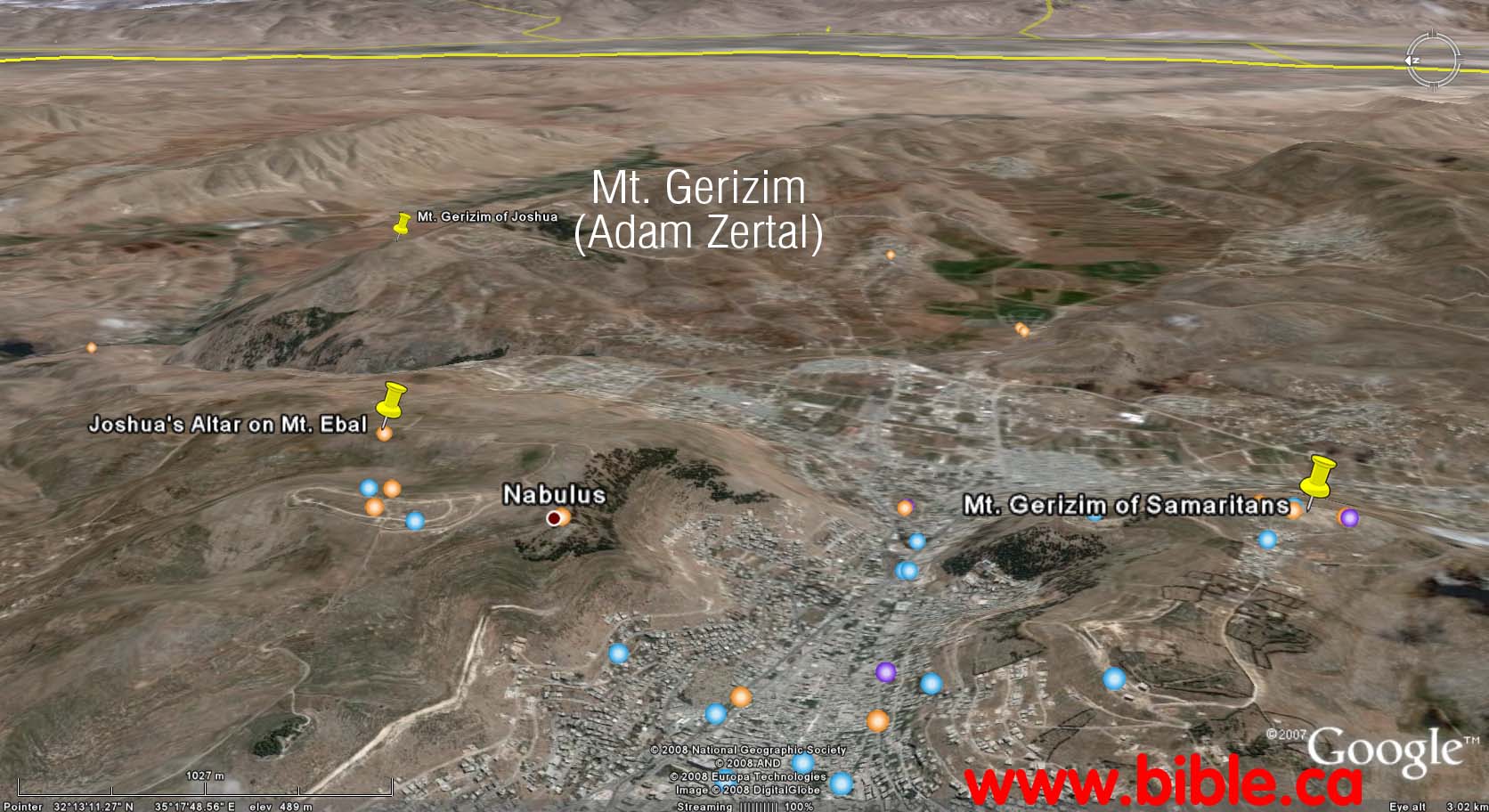
There is also a possibility that the Samaritans deliberately chose a different mountain because they wanted to create a new myth that Abraham sacrificed Isaac there. While Mt. Ebal is not in dispute, here is where Zertal believes Mt. Gerizim is really located. He chose this new location, because it is within view of a Hebrew altar he discovered which he believes to be Joshua's altar. One of the problems for Zertal, is that the altar doesn't directly point to his choice for Mt. Gerizim. Rather the altar is facing the open plains to the left of Zertal's Mt. Gerizim. Surely the altar would point directly to Mt. Gerizim since it was directly in view.
 .
.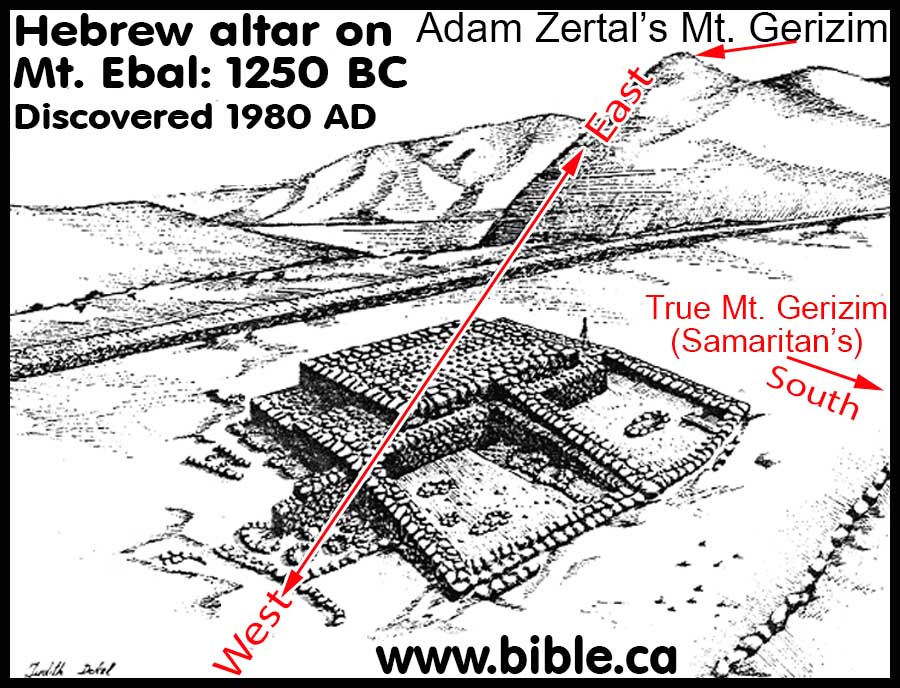
Here is a close up of Zertal's choice for Mt. Gerizim taken from the south side of the altar. It is unfortunate that Zertal carries on the tradition of those orthodox Jews who lived from 400 BC - 30 AD that the Samaritans had chosen the wrong mountain for Mt. Gerizim. The Samaritans chose the correct mountain. Zertal is wrong.
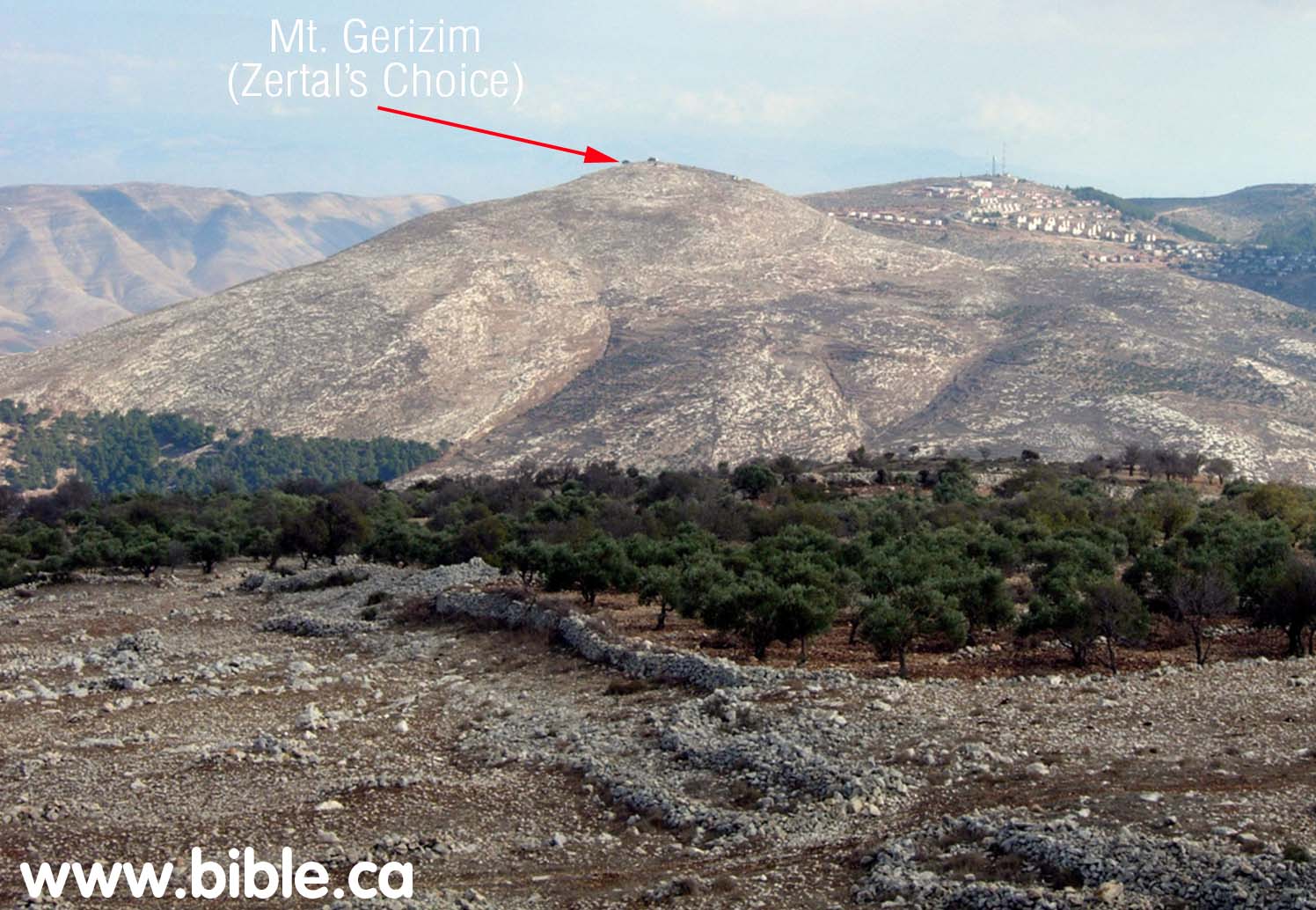
Conclusion:
- Jesus made it clear to the woman at the well, that the Samaritan’s choice of Mt. Gerizim as the place “God put his name” is wrong.
a. "“Our fathers worshiped in this mountain, and you people say that in Jerusalem is the place where men ought to worship.” Jesus said to her, “Woman, believe Me, an hour is coming when neither in this mountain nor in Jerusalem will you worship the Father. “You worship what you do not know; we worship what we know, for salvation is from the Jews. “But an hour is coming, and now is, when the true worshipers will worship the Father in spirit and truth; for such people the Father seeks to be His worshipers. “God is spirit, and those who worship Him must worship in spirit and truth.”" (John 4:20–24)
- The Samaritans built their pagan temple over top of the original location of Joshua’s altar on Mt. Gerizim.
- The Bible locates Mt. Gerizim beside Shechem.
- The Samaritan temple on Mt. Gerizim venerated the Altar of Joshua which was built on Mt. Gerizim. The Samaritans had chose Mt. Gerizim as their holy place because that is the original location of Joshua’s Altar.
- The Samaritan location at Shechem (Nabulus) is correct. The orthodox Jewish locations near Gilgal are wrong.
- Zertal's choice for Mt. Gerizim is wrong.
- Eusebius is also wrong for locating the two mountains beside Jericho and Gilgal.
- The correct location for Mt. Gerizim is where the Samaritans chose it.
- Adam Zertal was looking for Joshuah’s altar on the wrong mountain and what he found we are certain is not Joshua’s altar because it dates to 1250 BC, a full 150 years too late.
- See also: Archeology of Joshua's Altar.
- See also: Full outline on Joshua’s altar on Mt. Gerizim NOT Mt. Ebal
- See also: The Samaritan Pentateuch
By Steve Rudd 2006 AD: Contact the author for comments, input or corrections.
